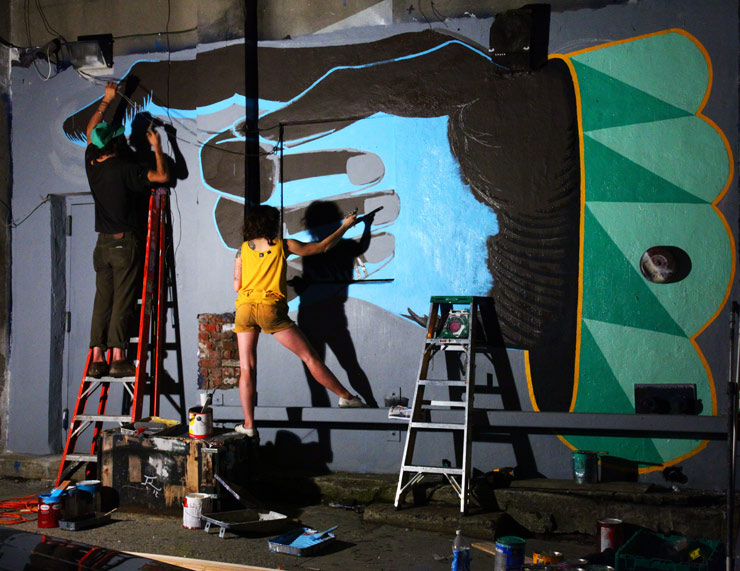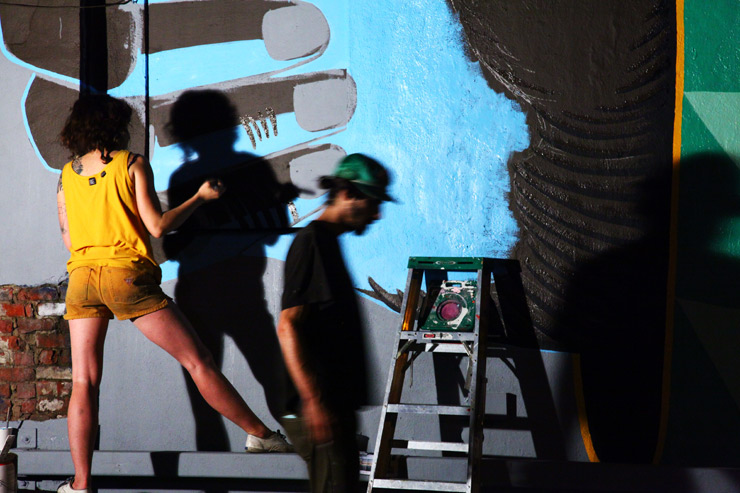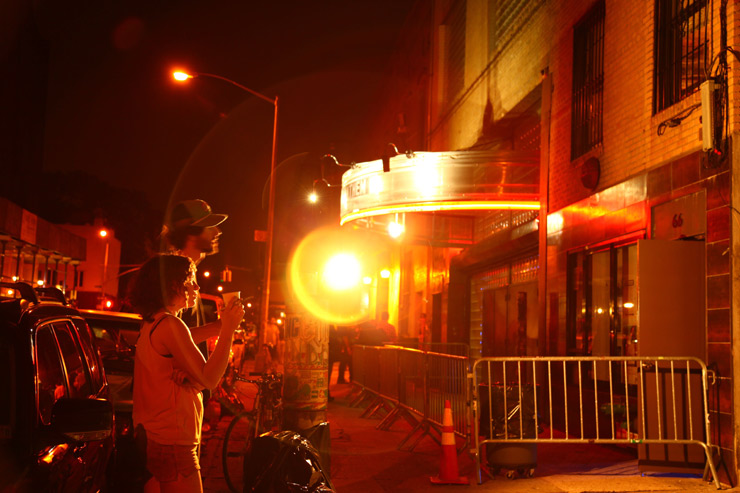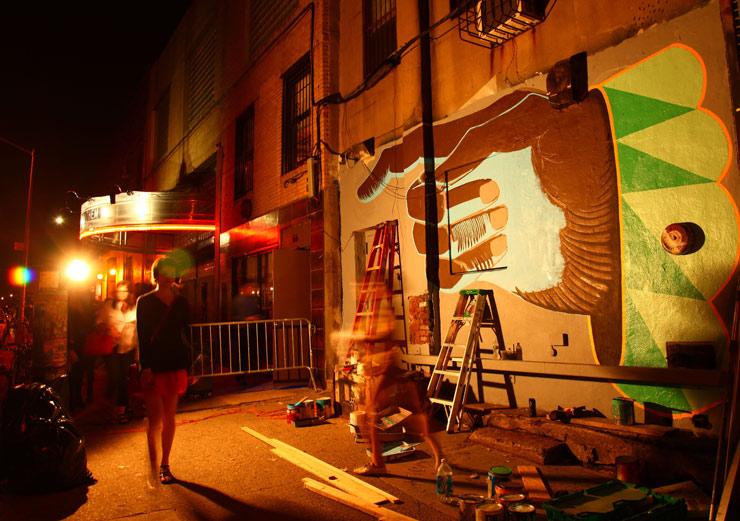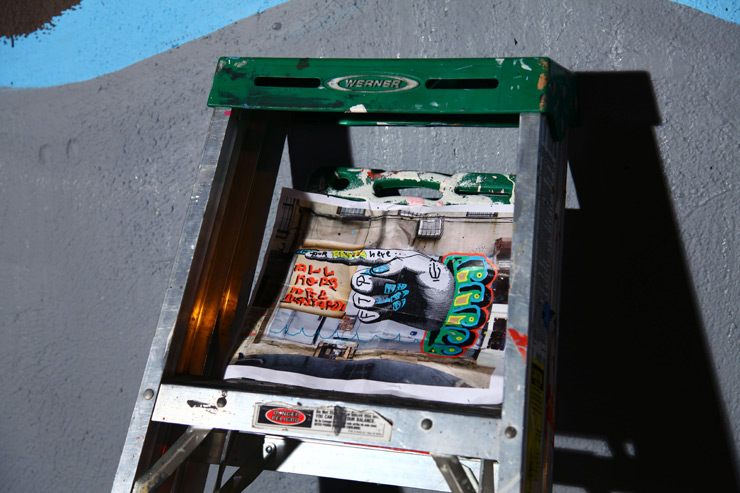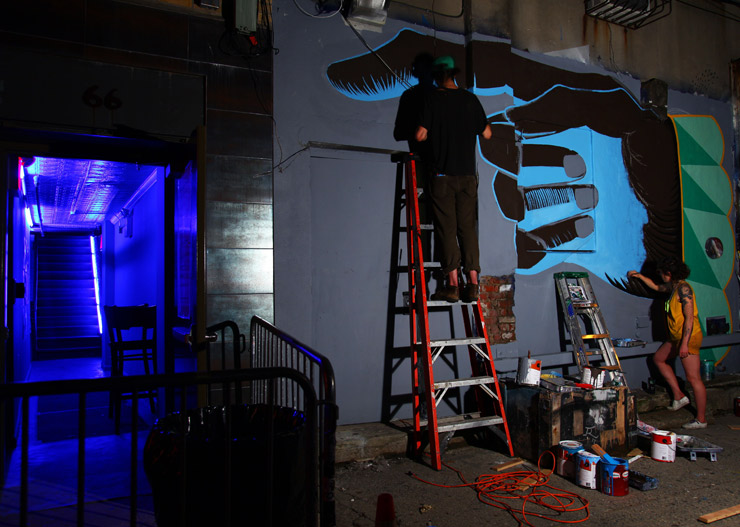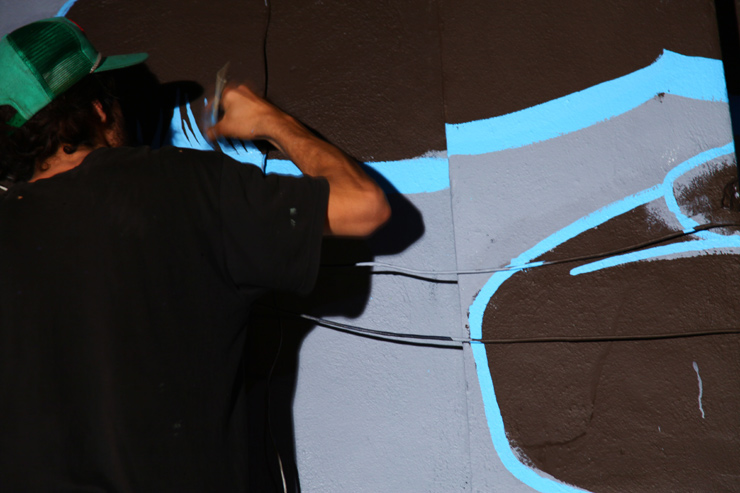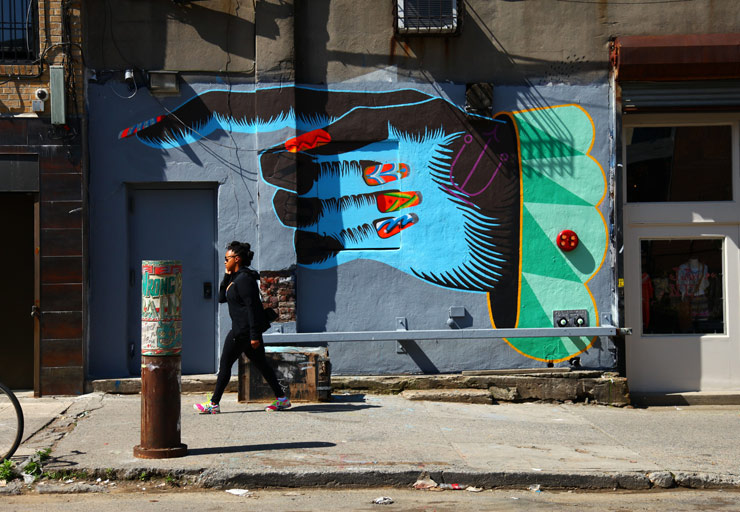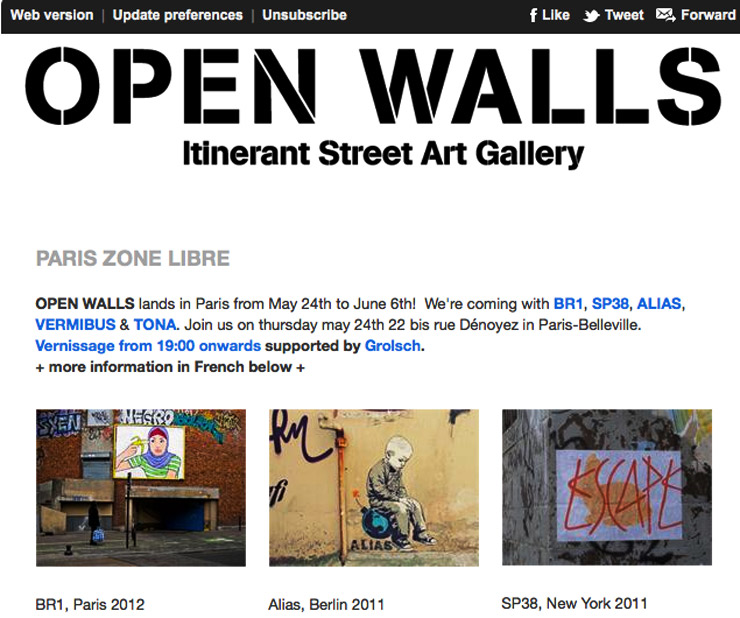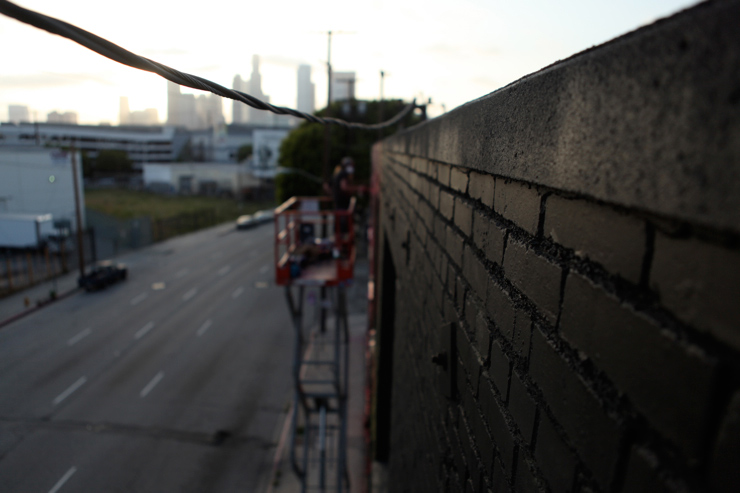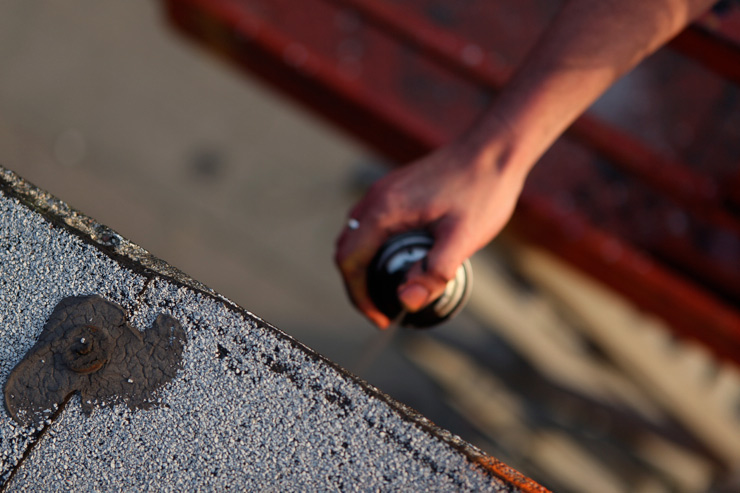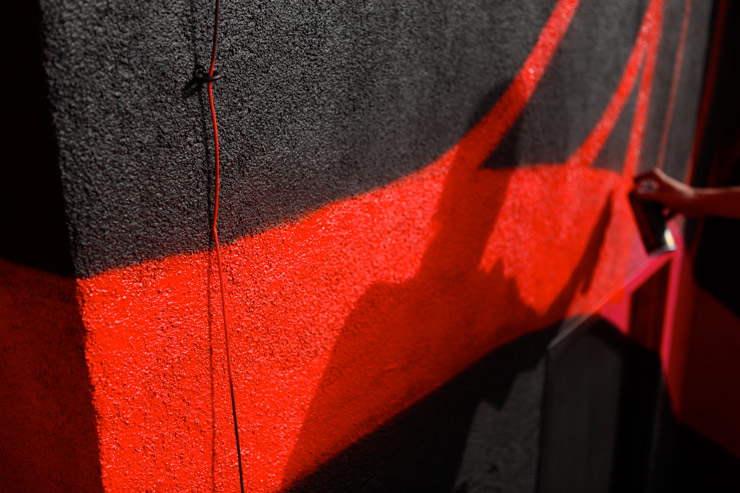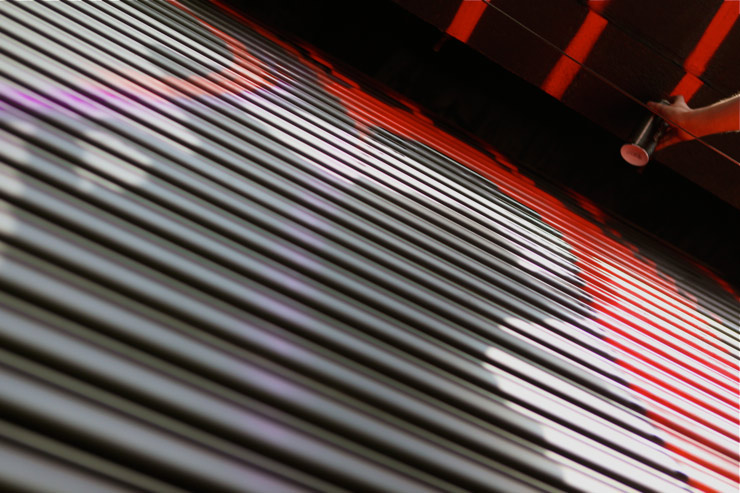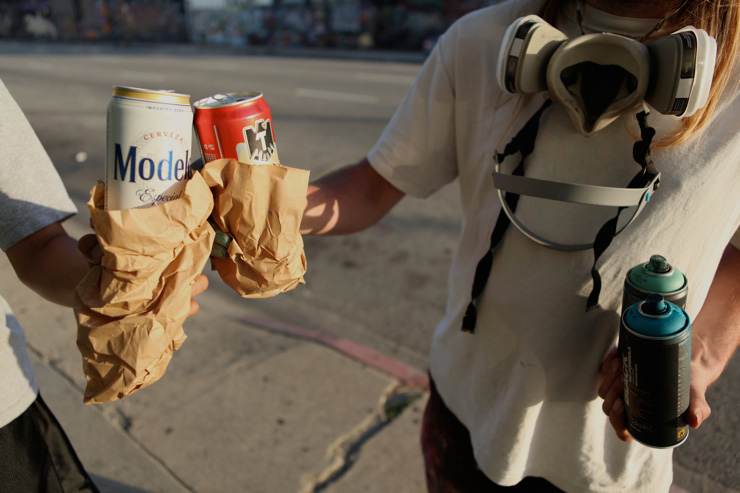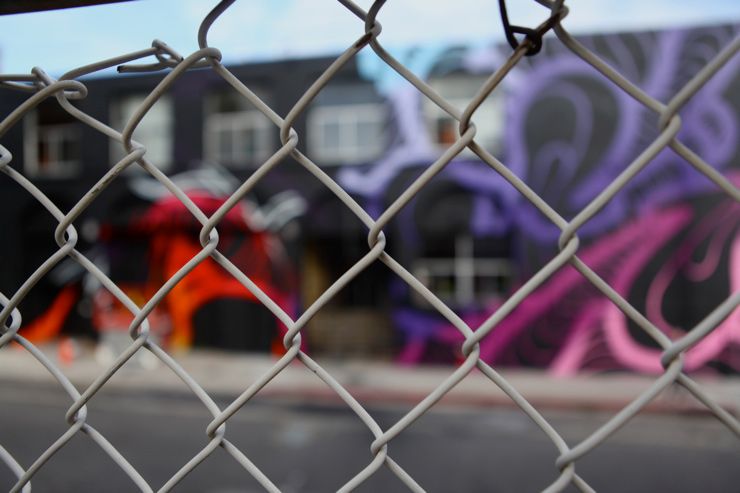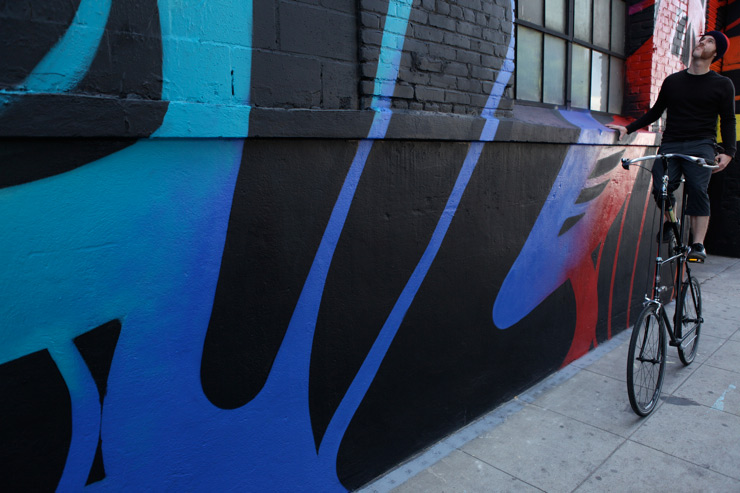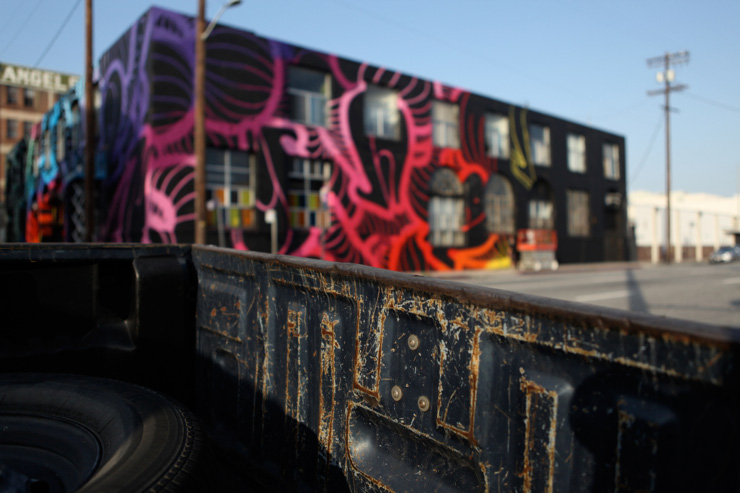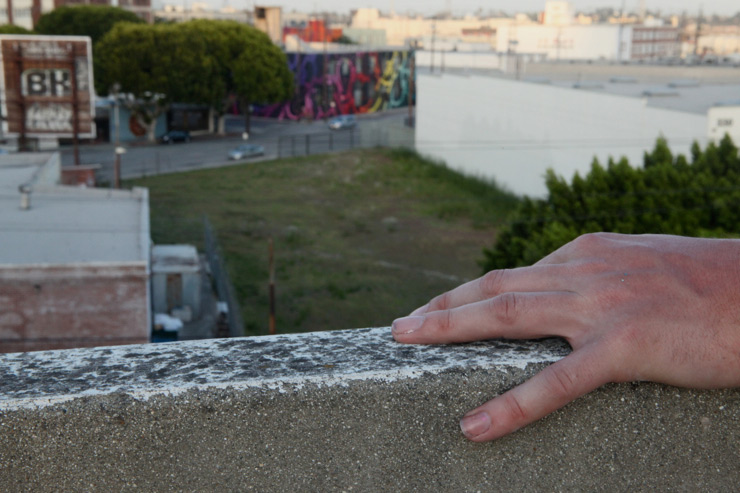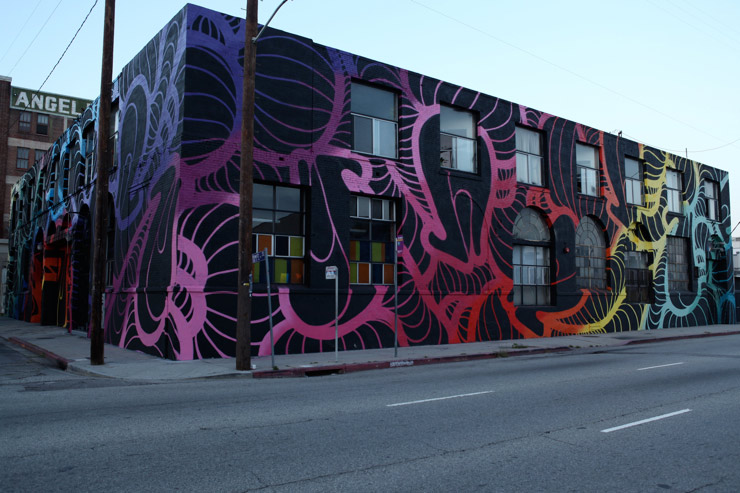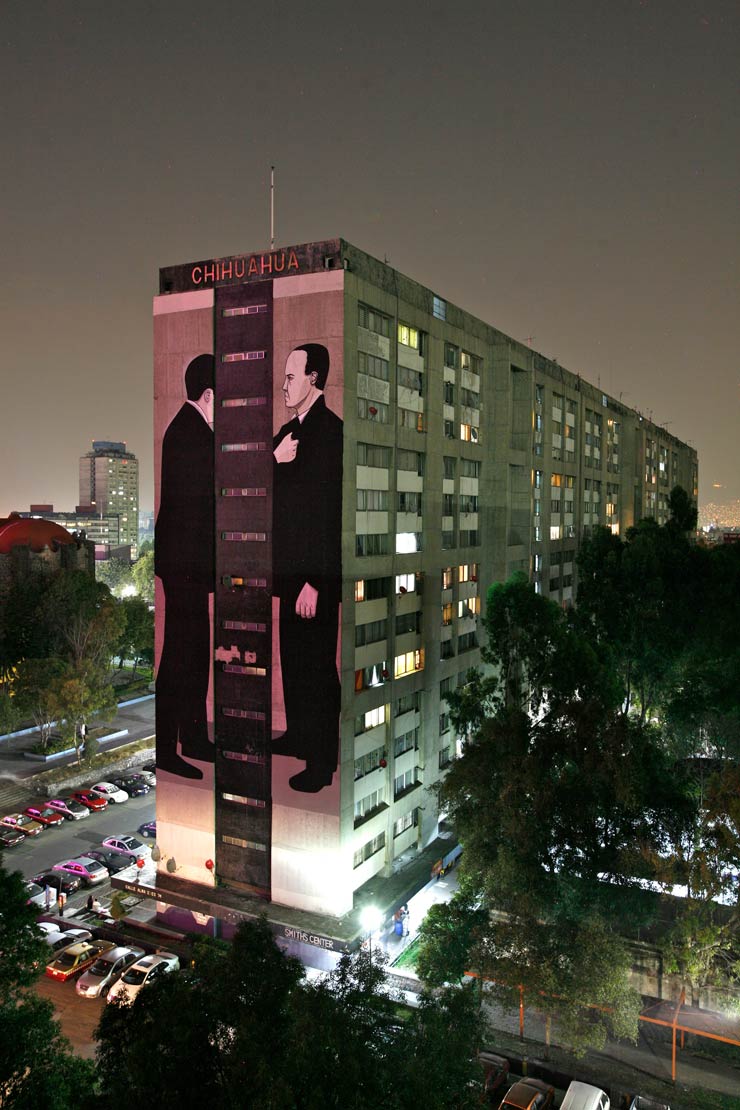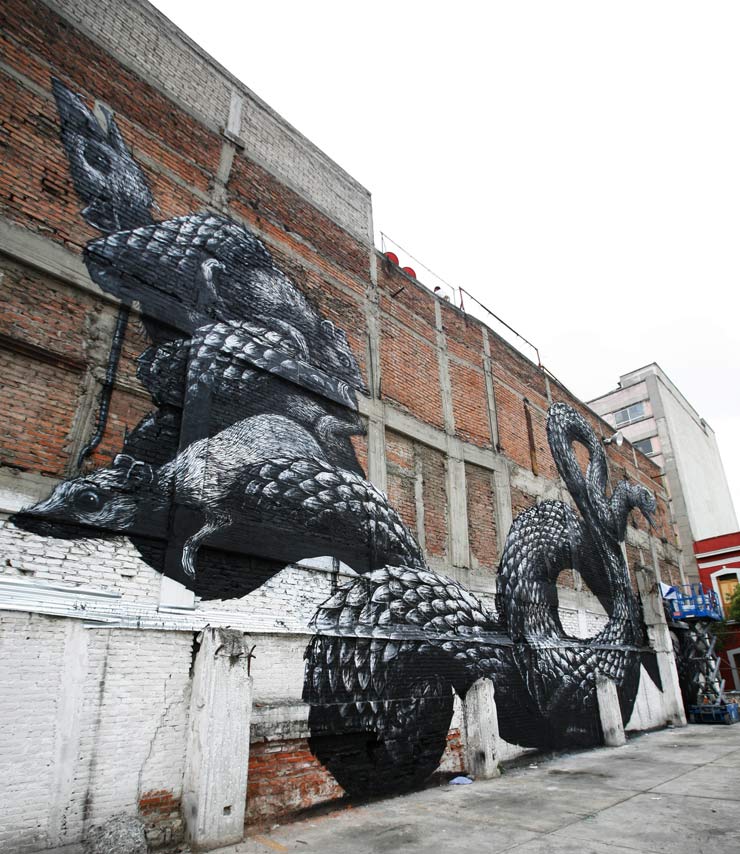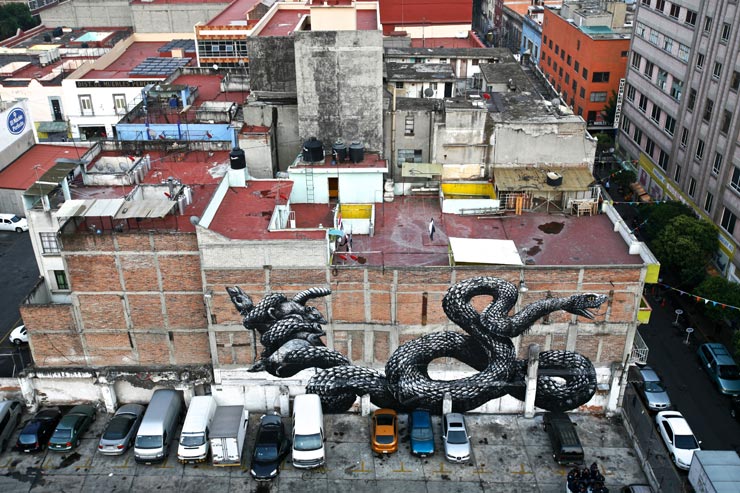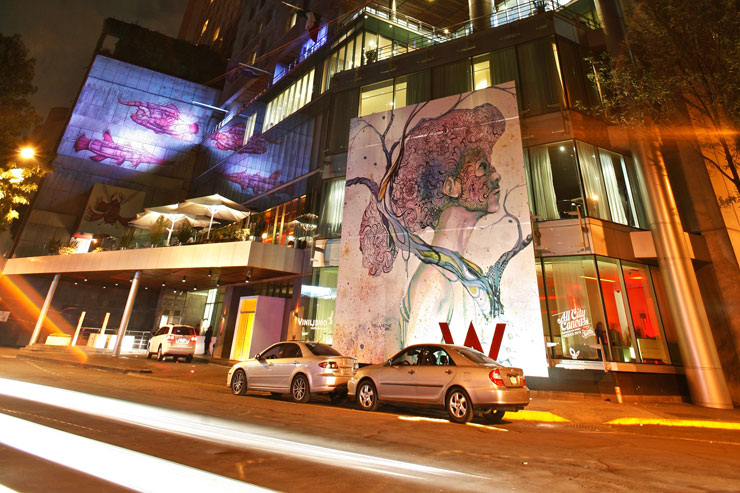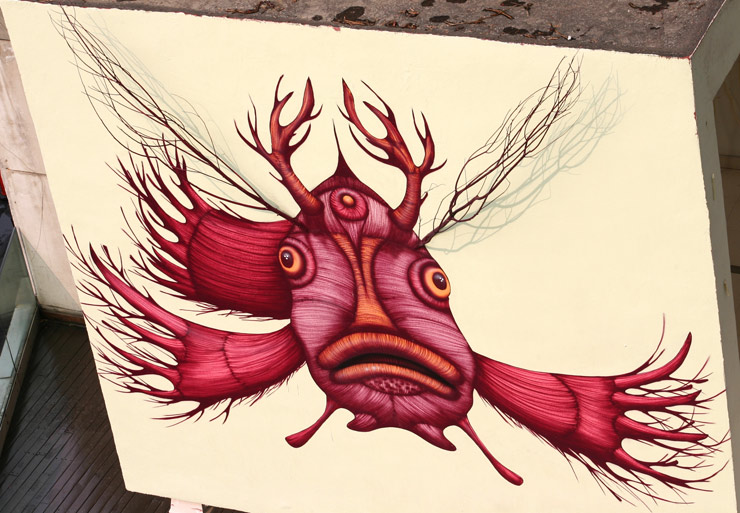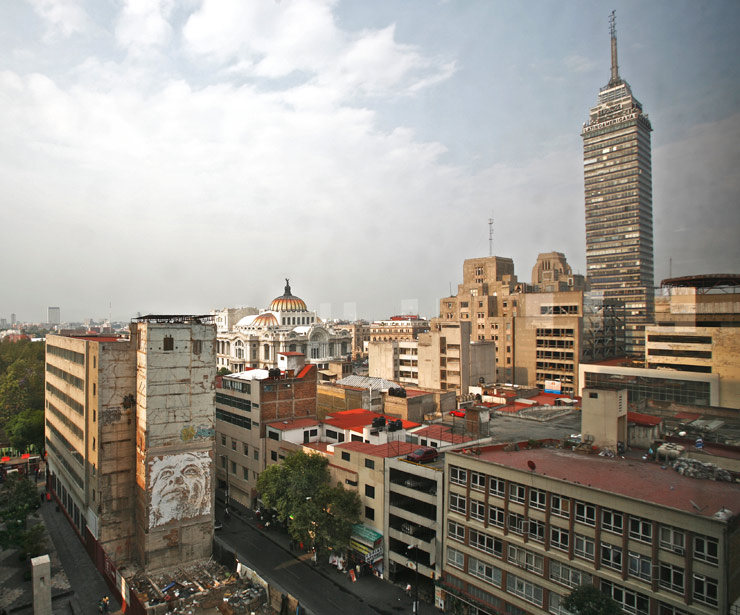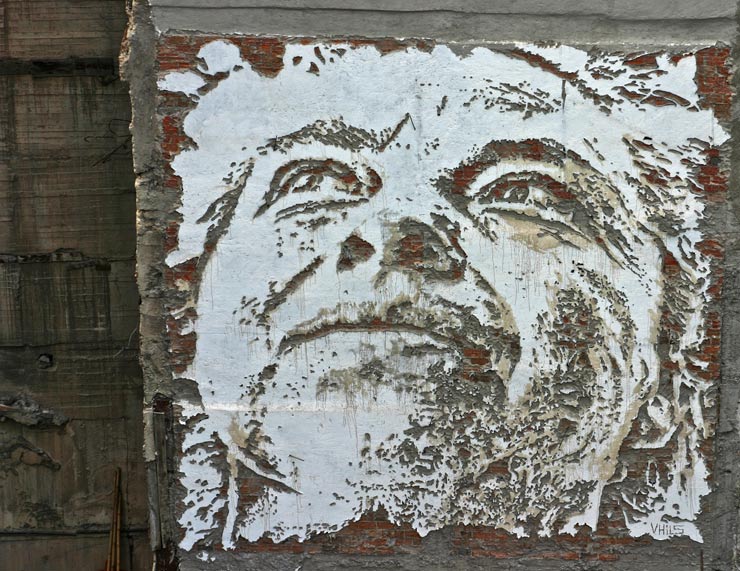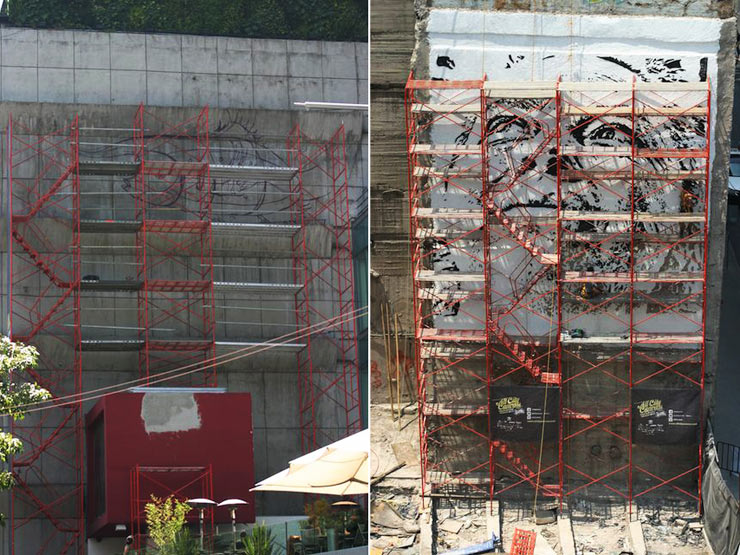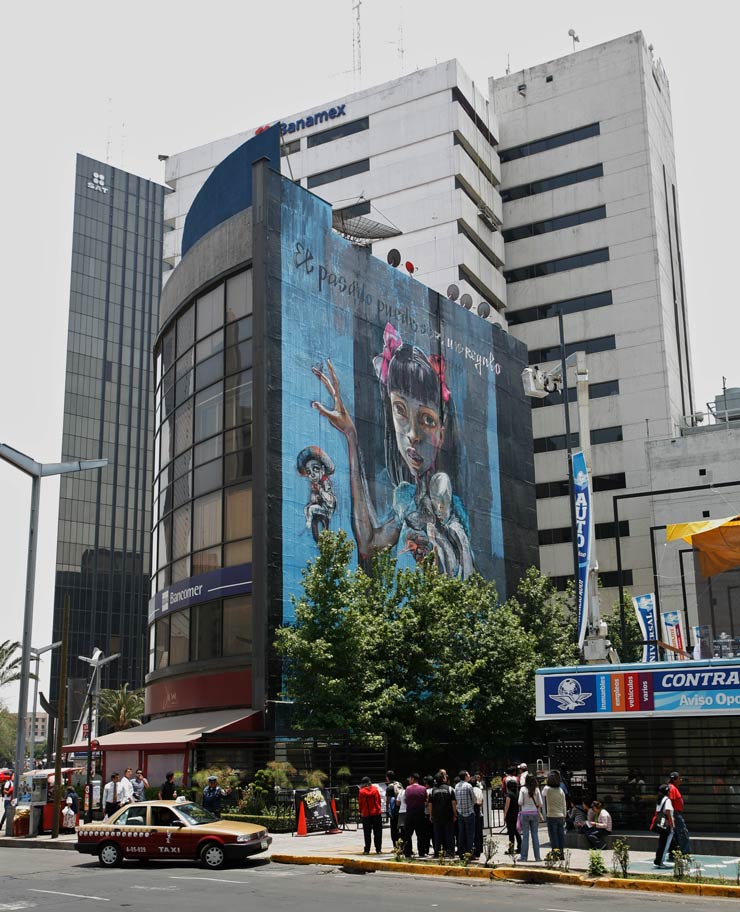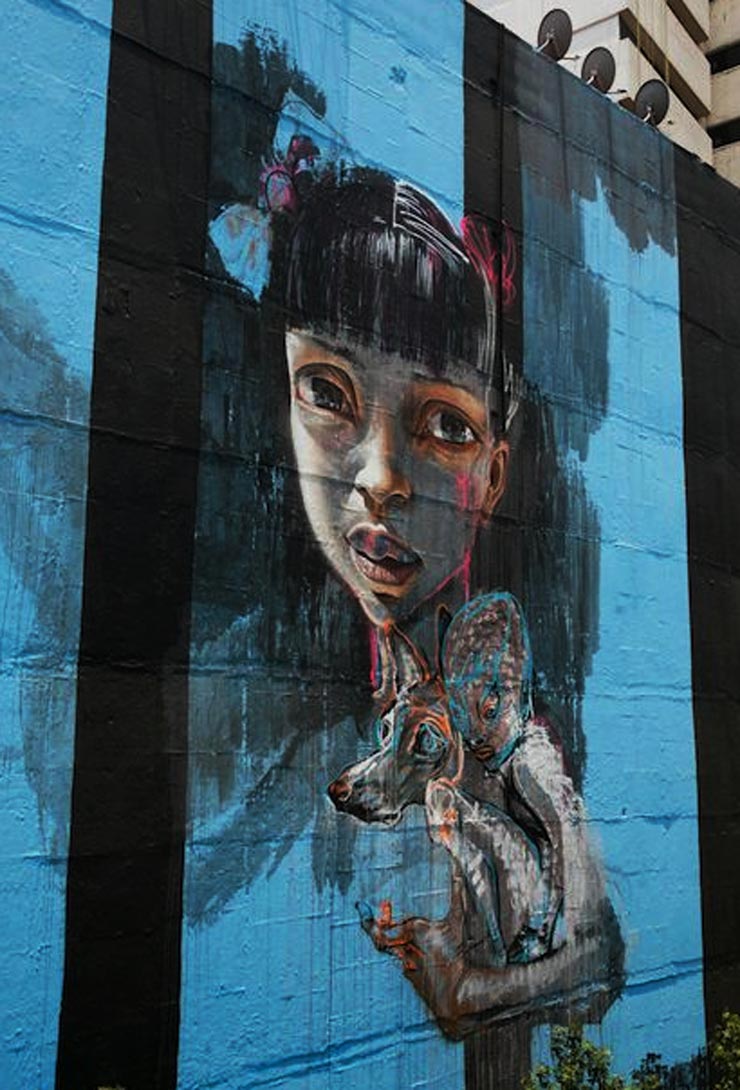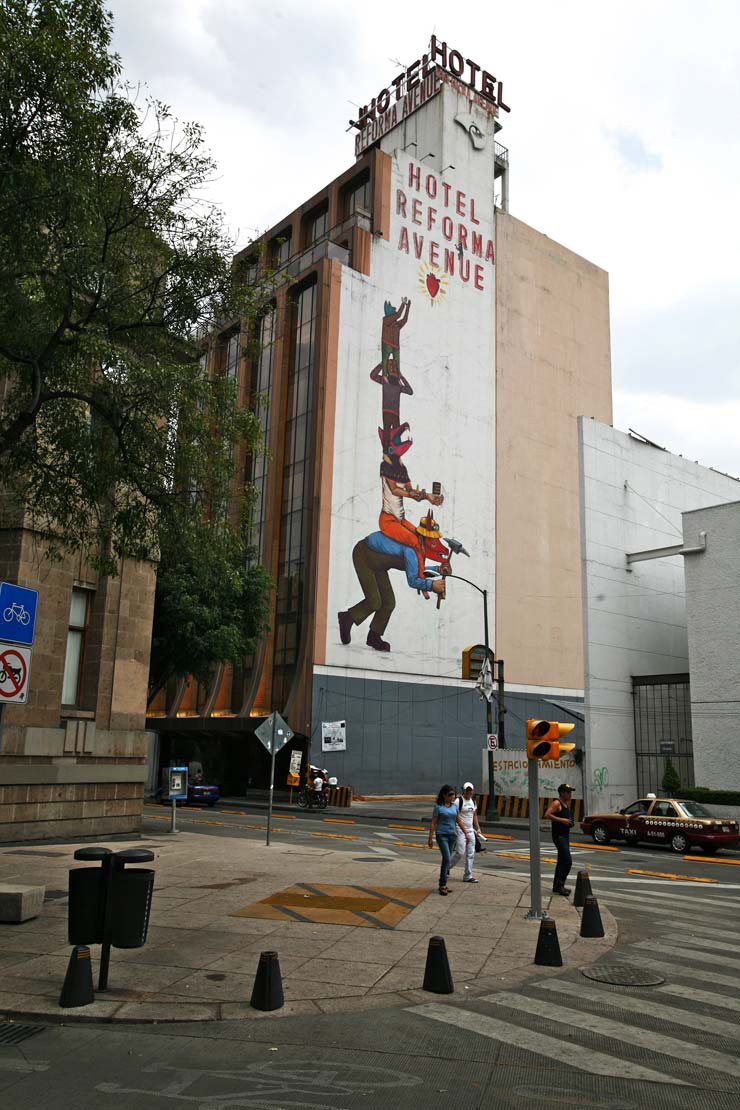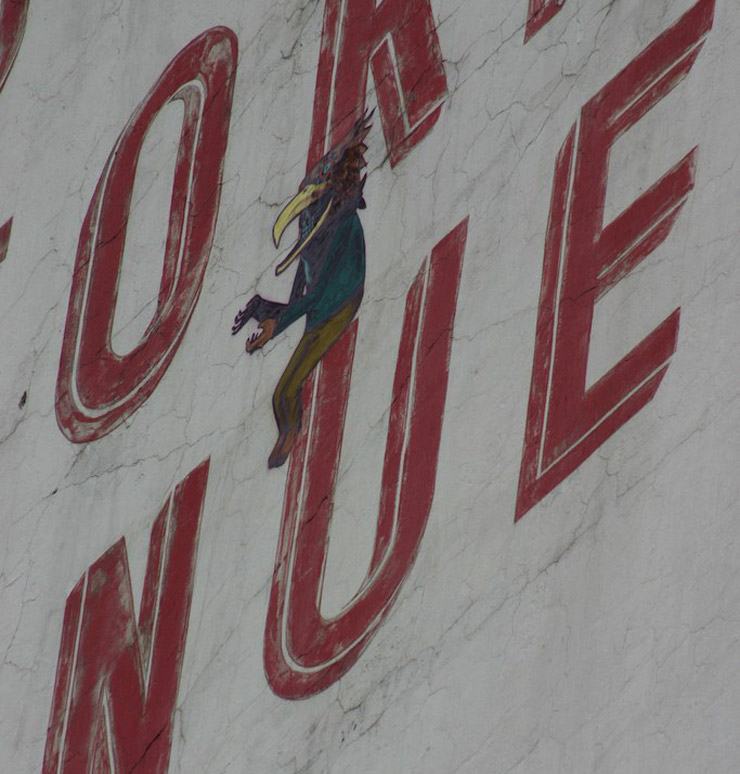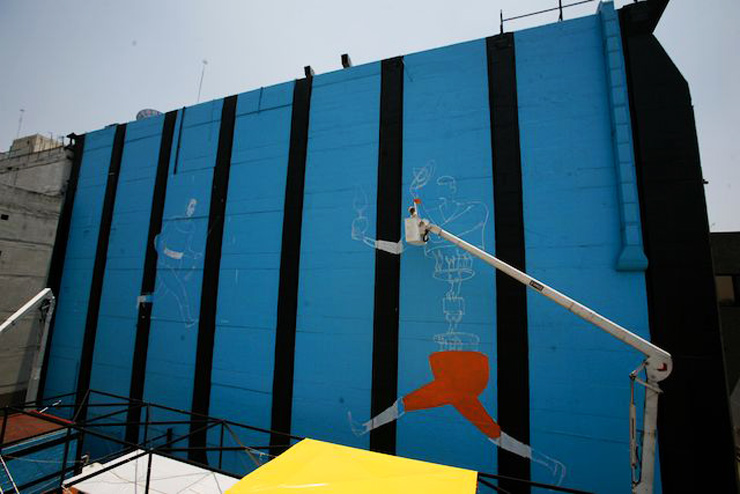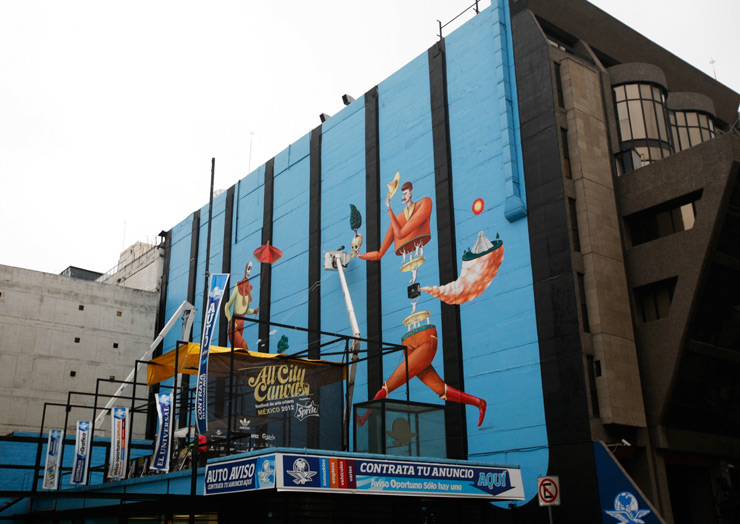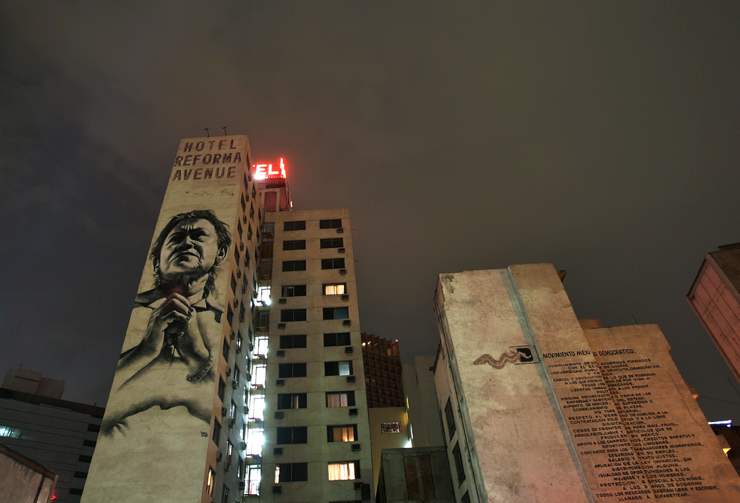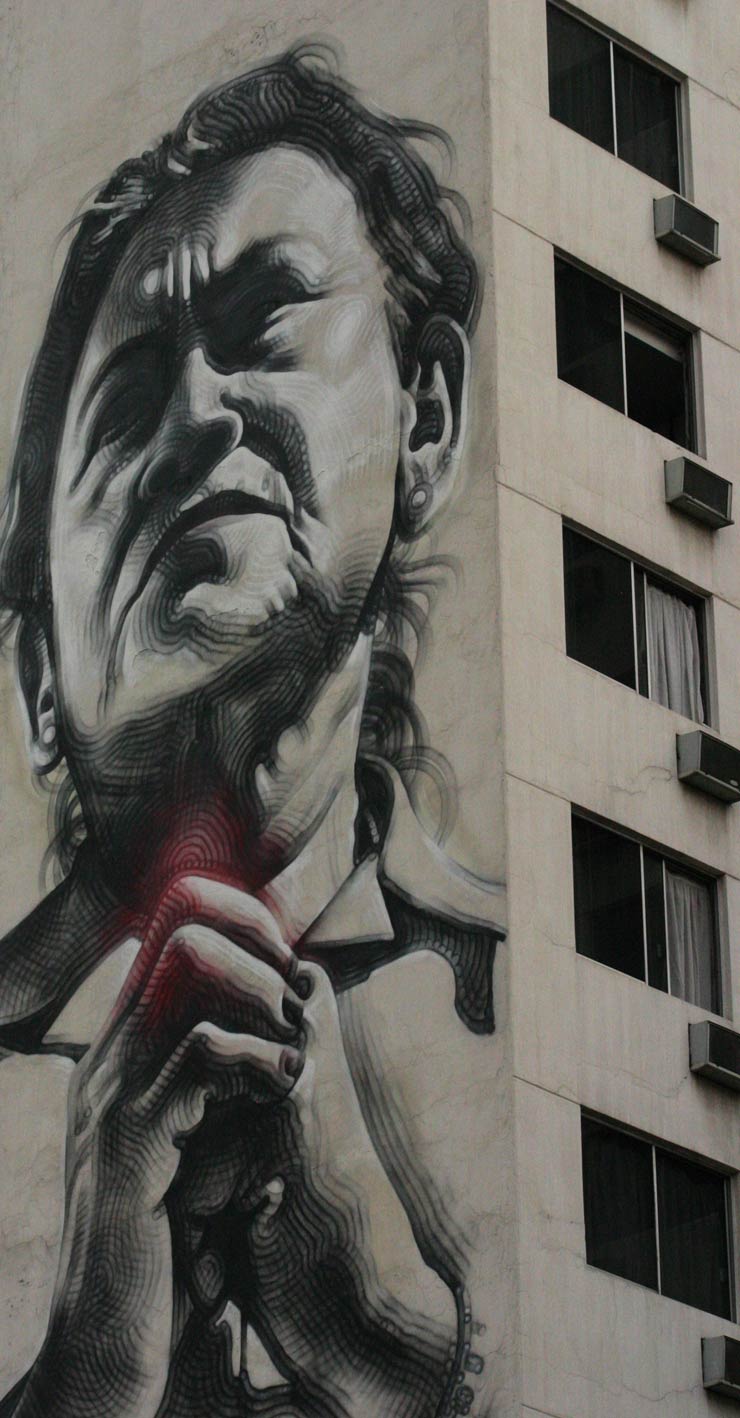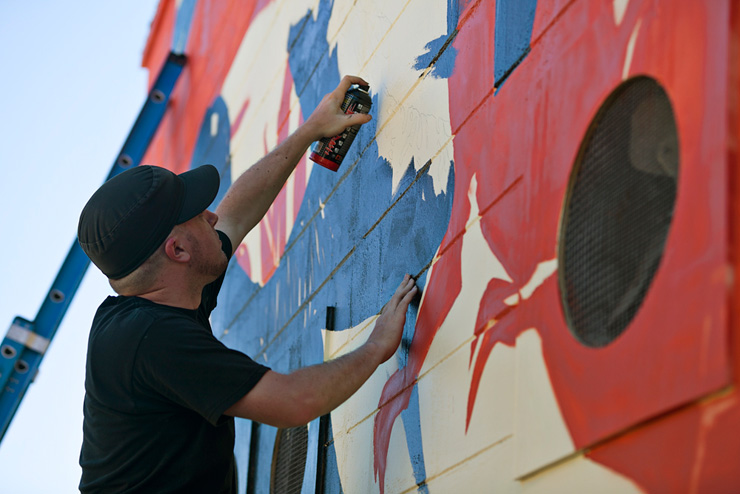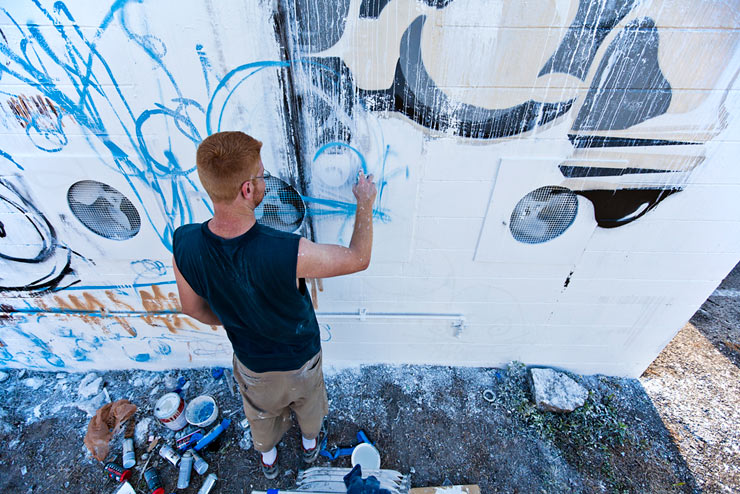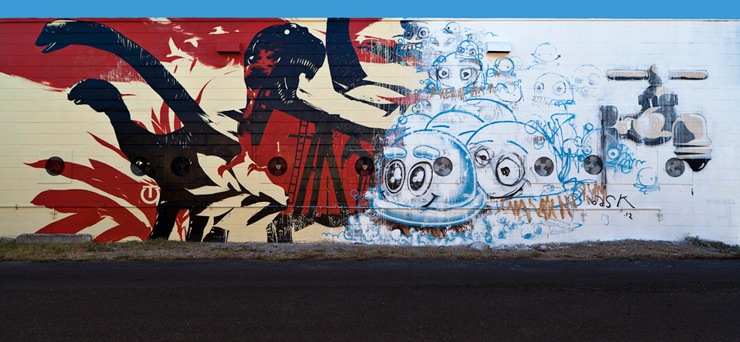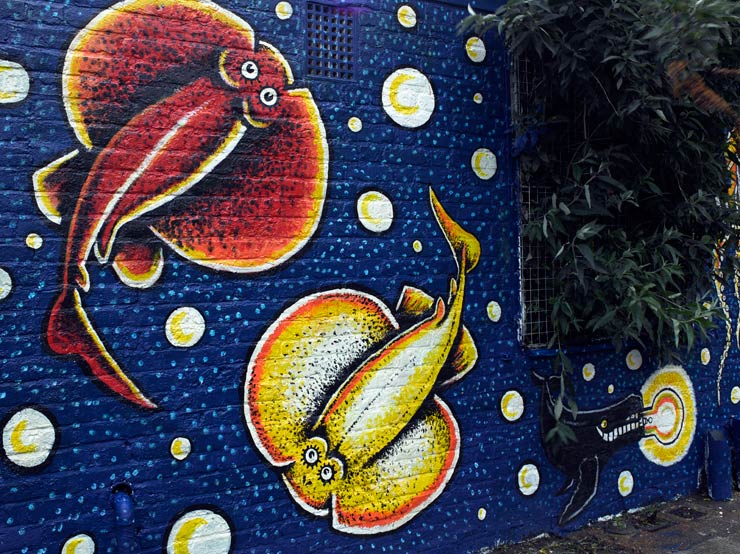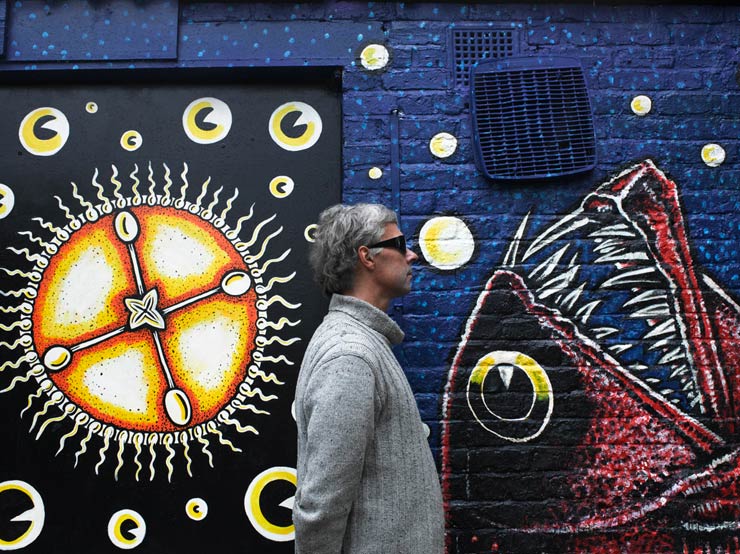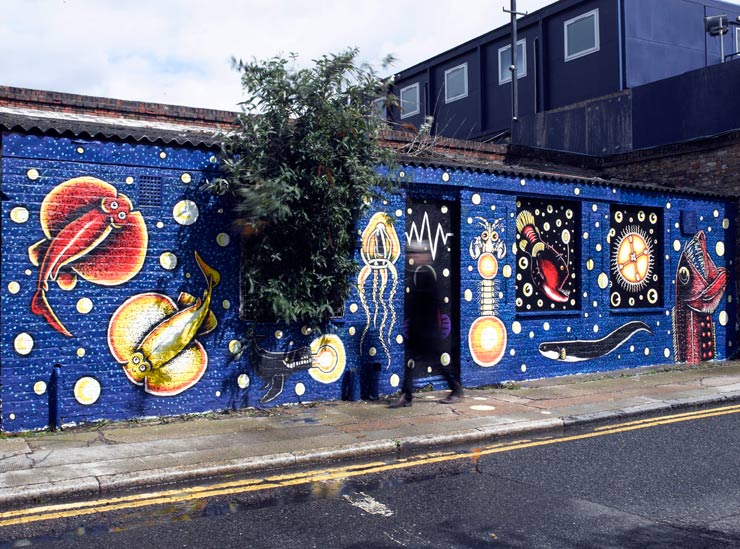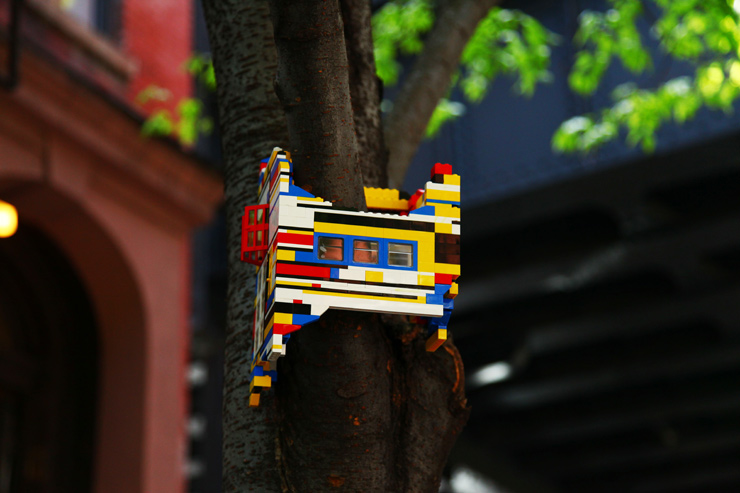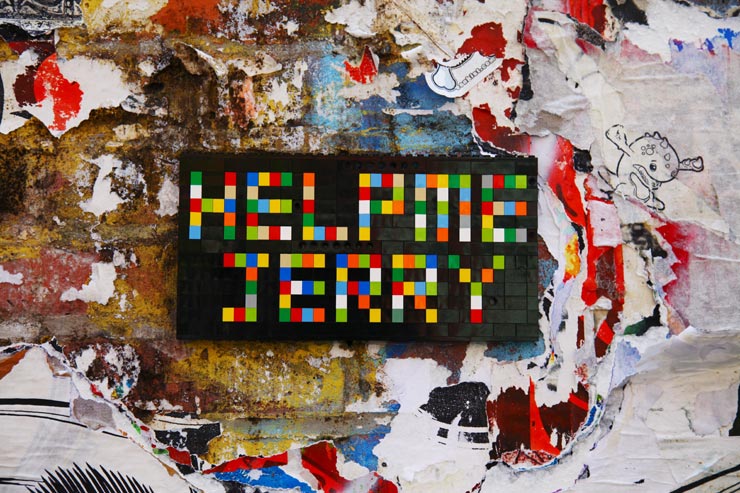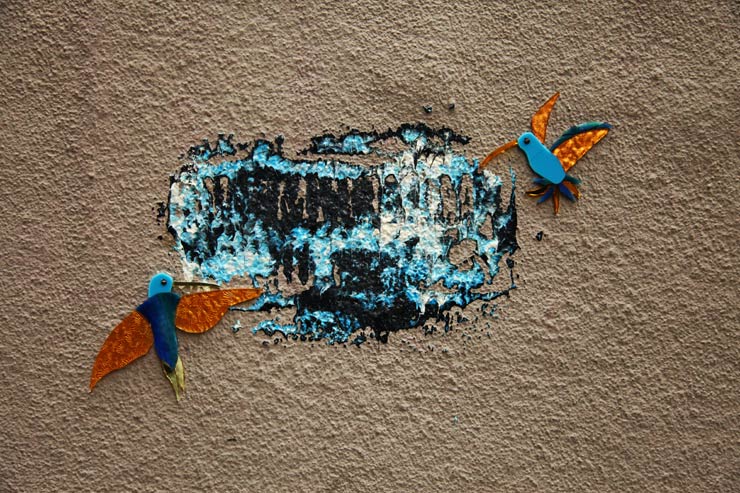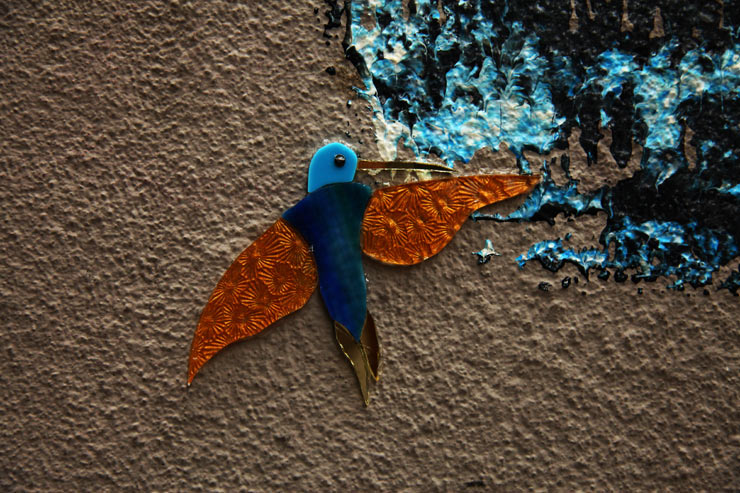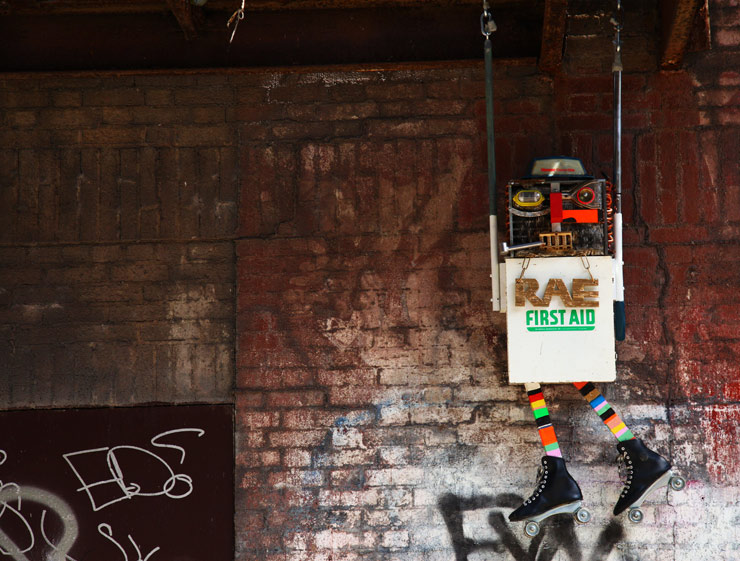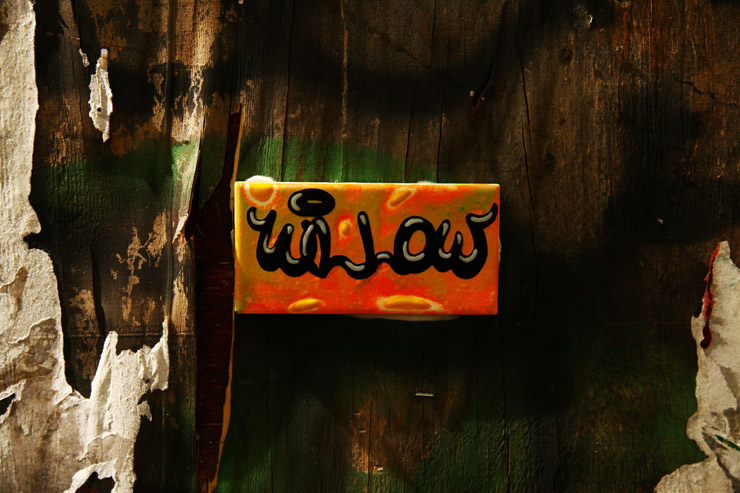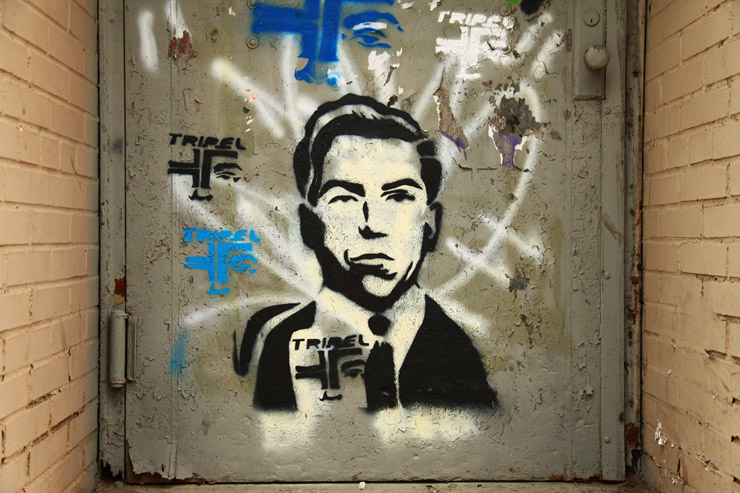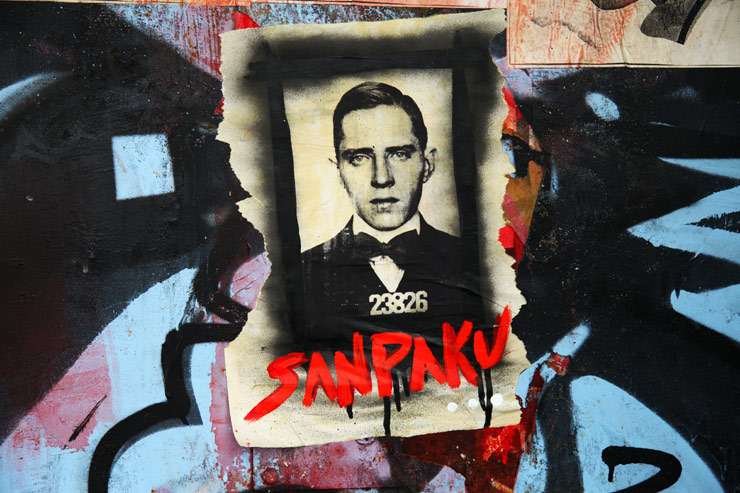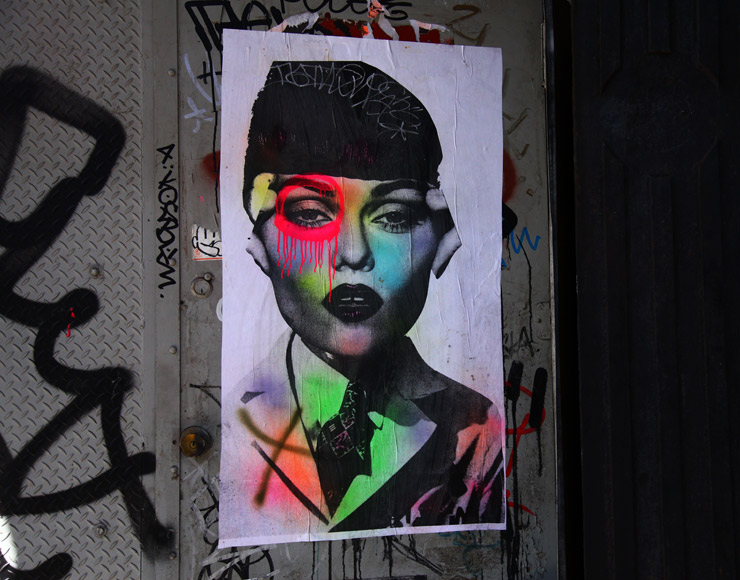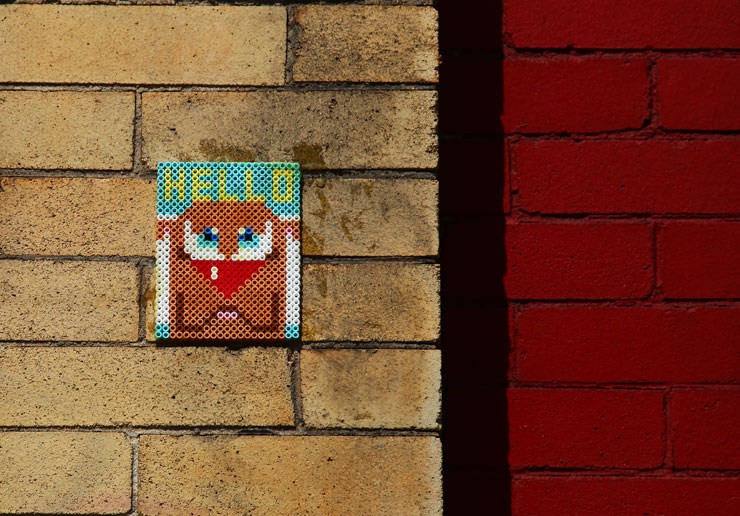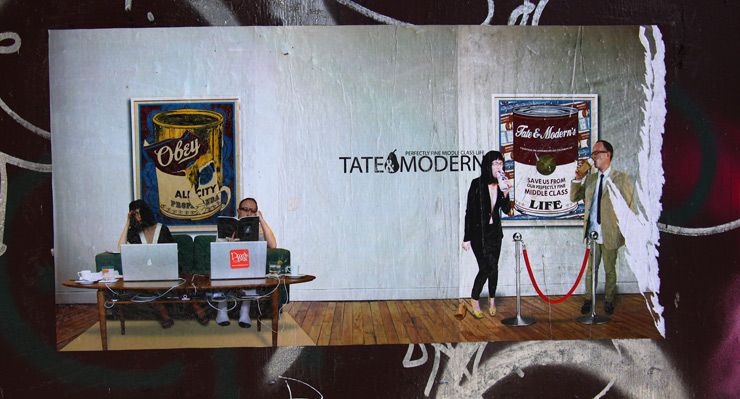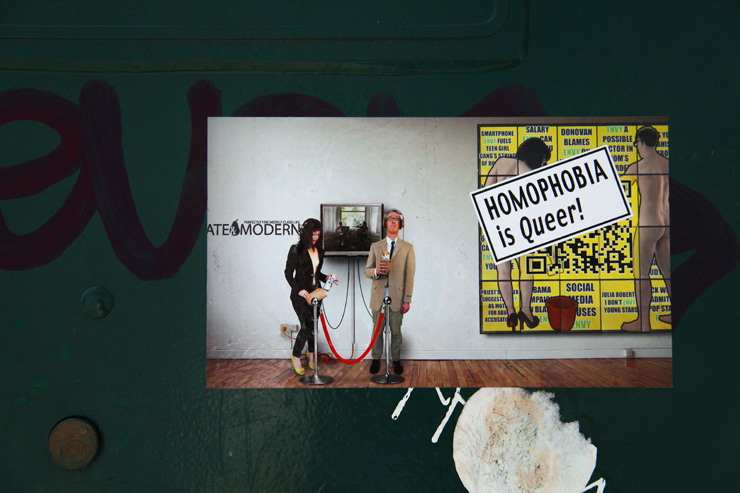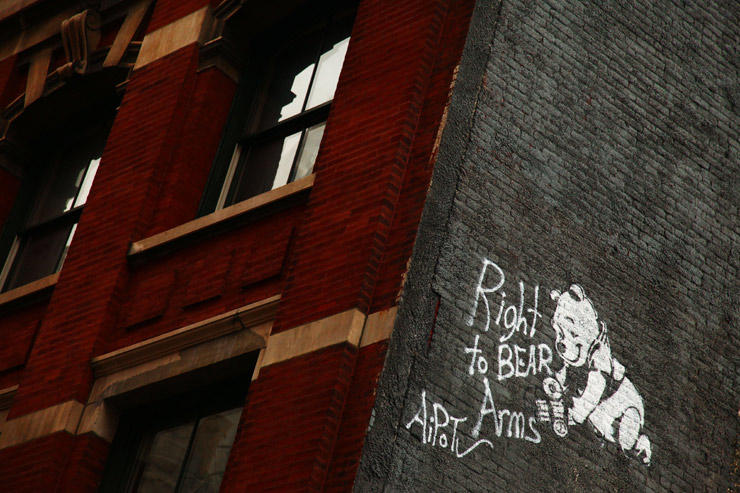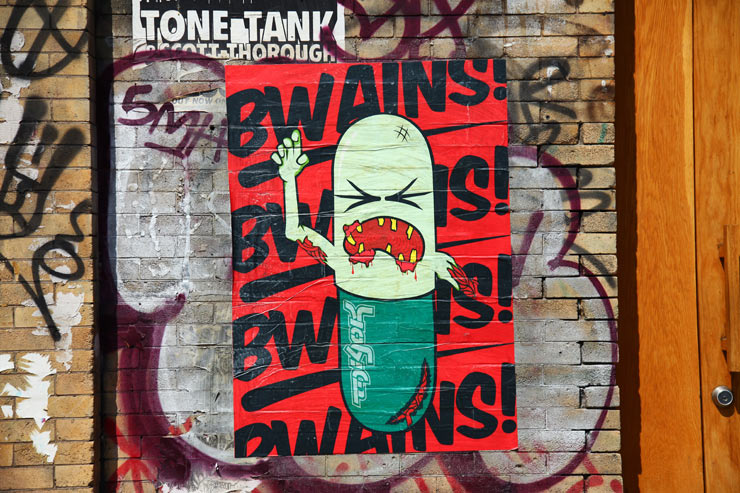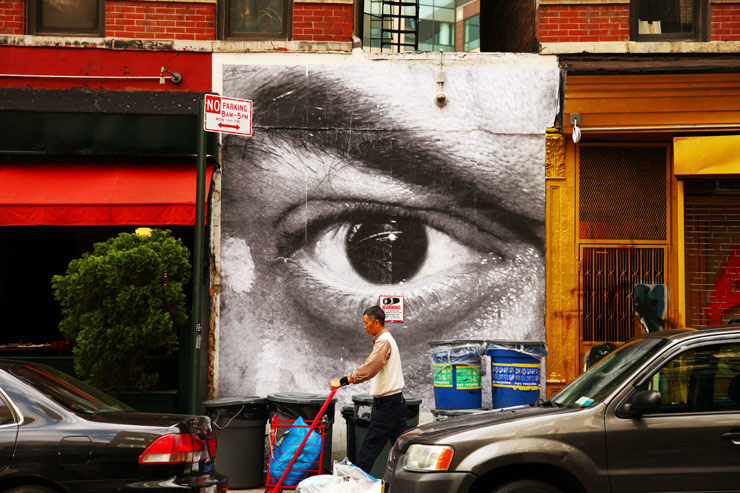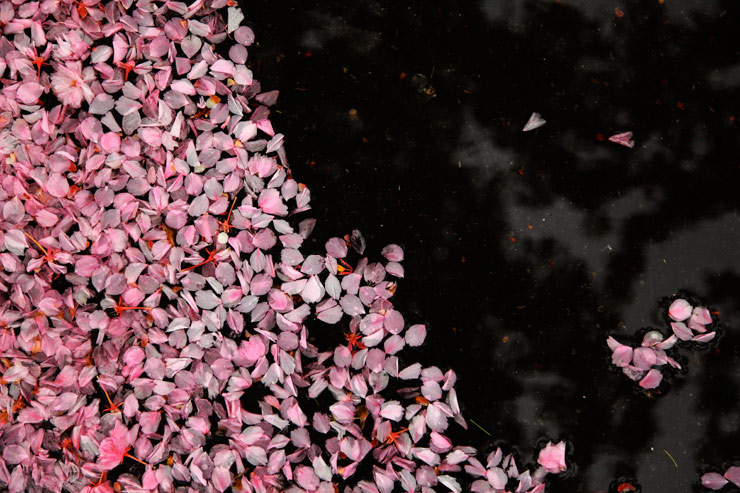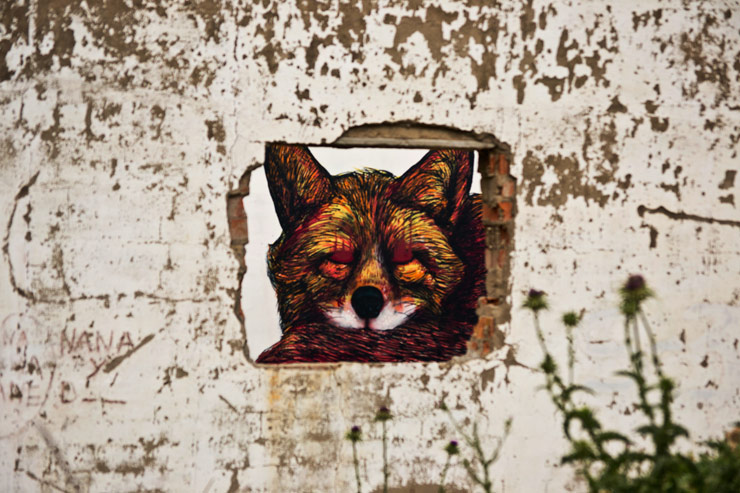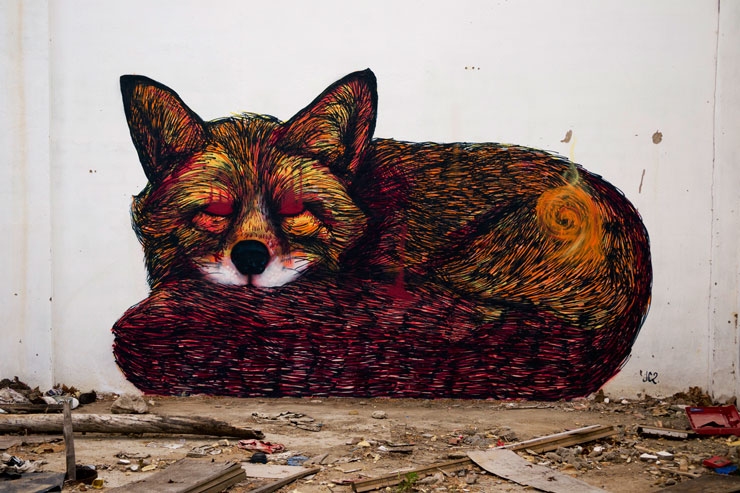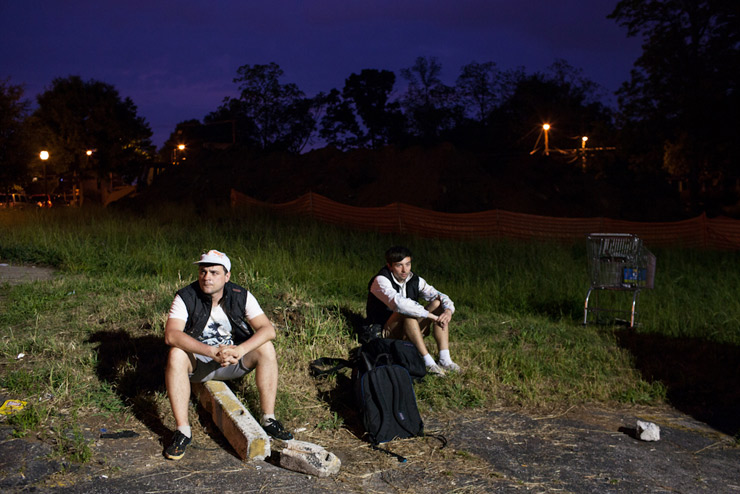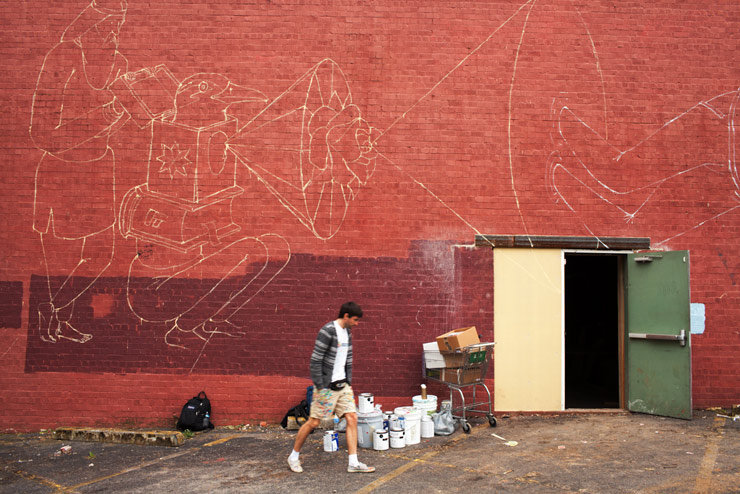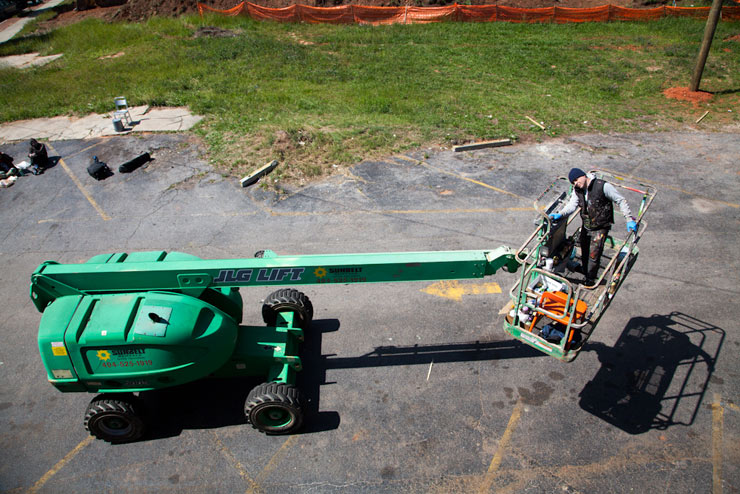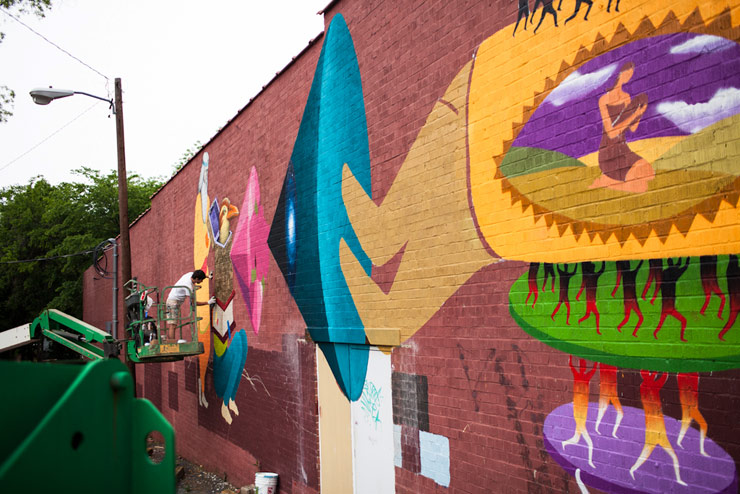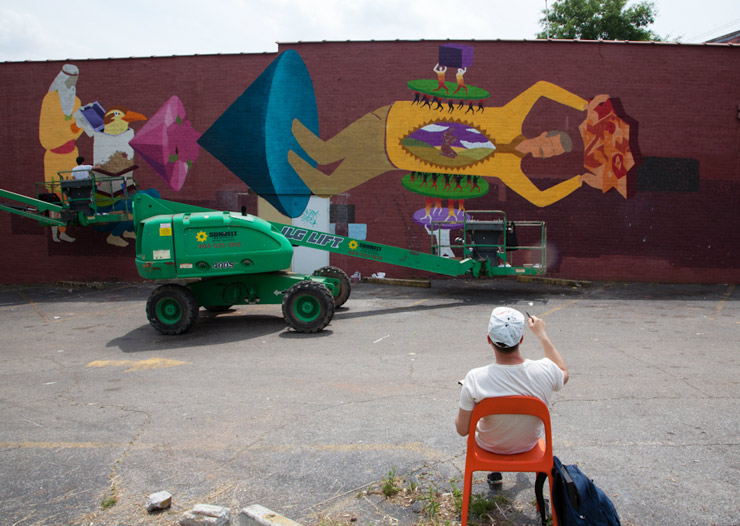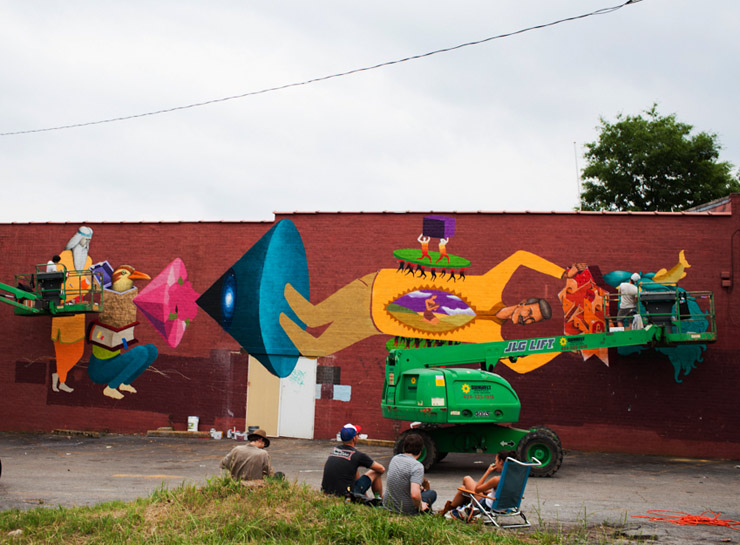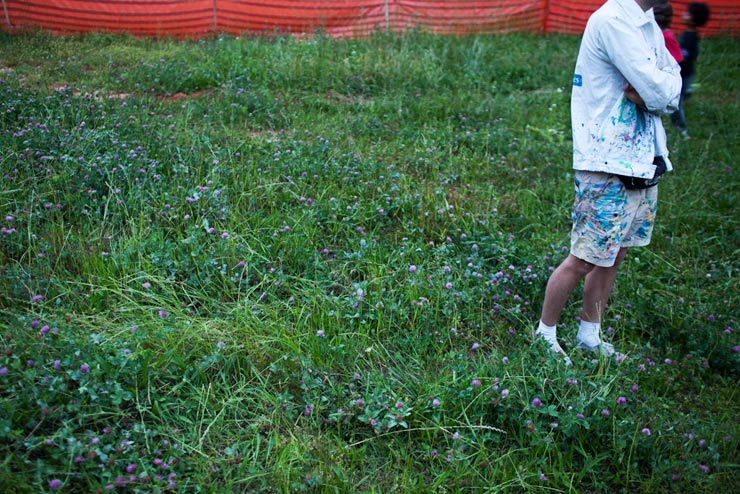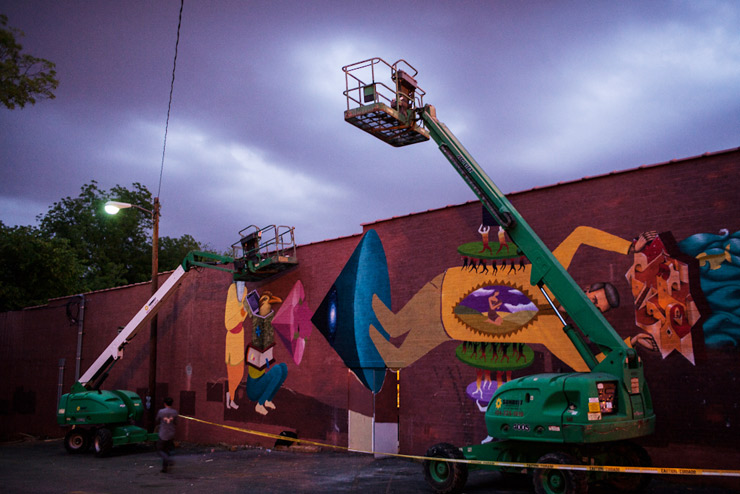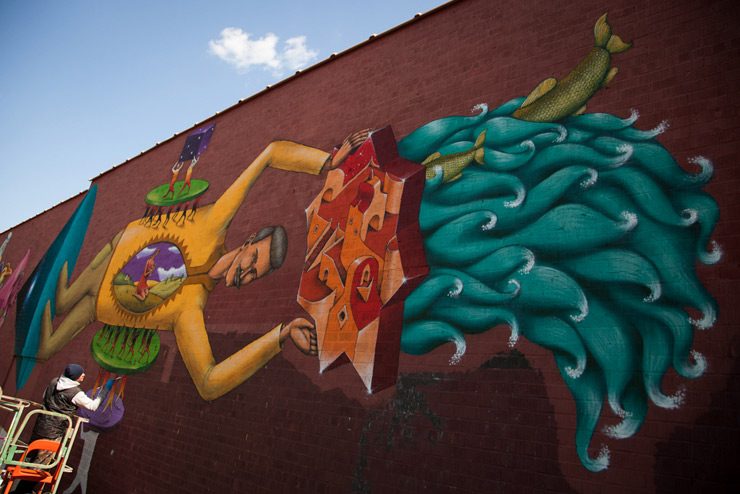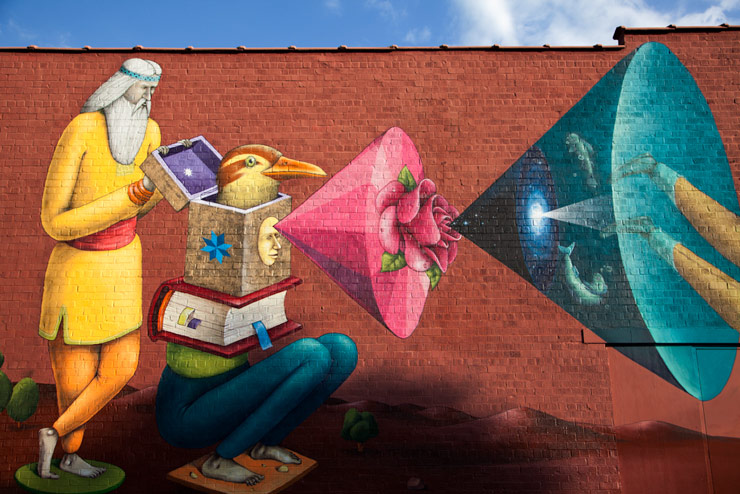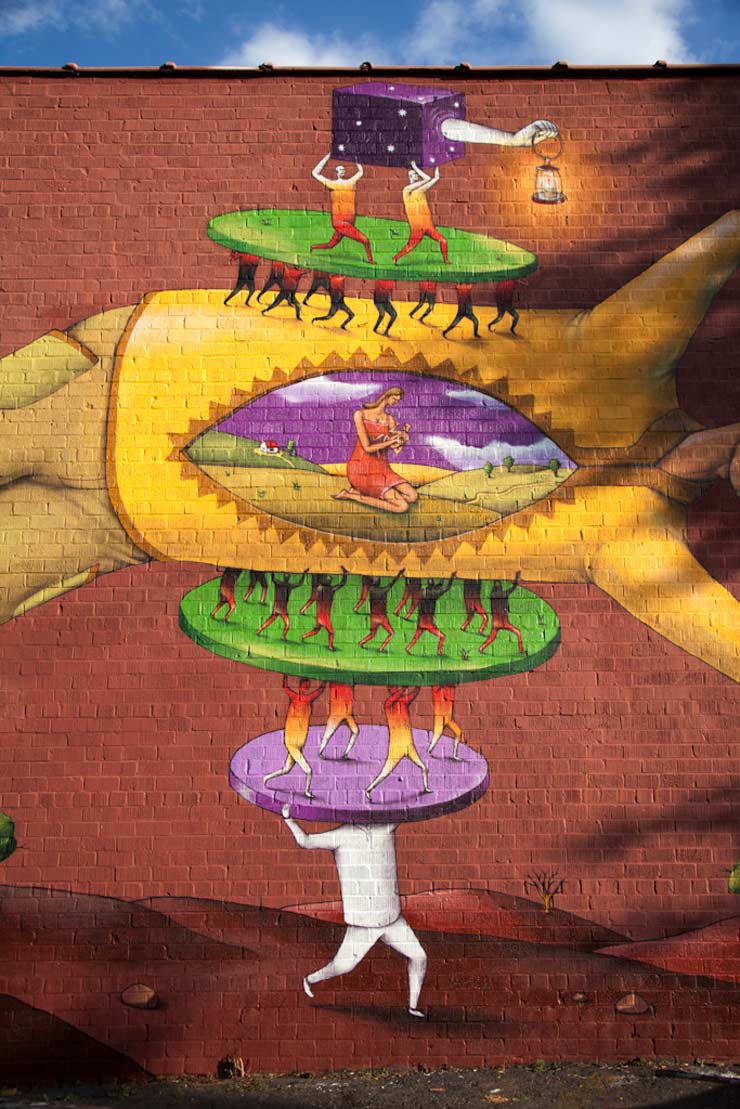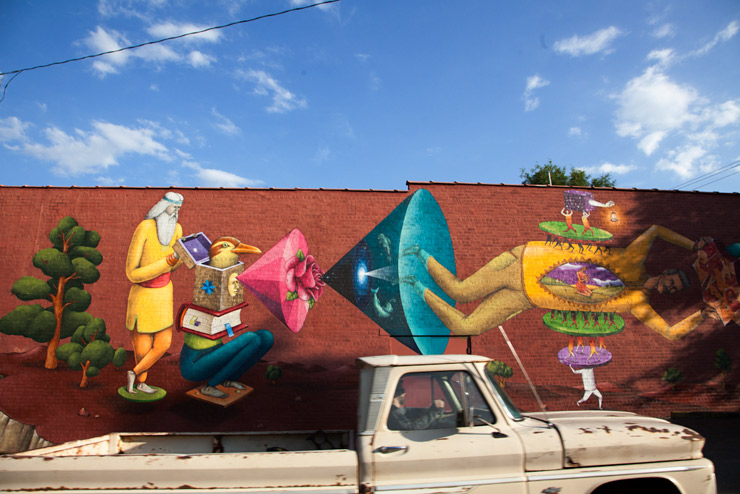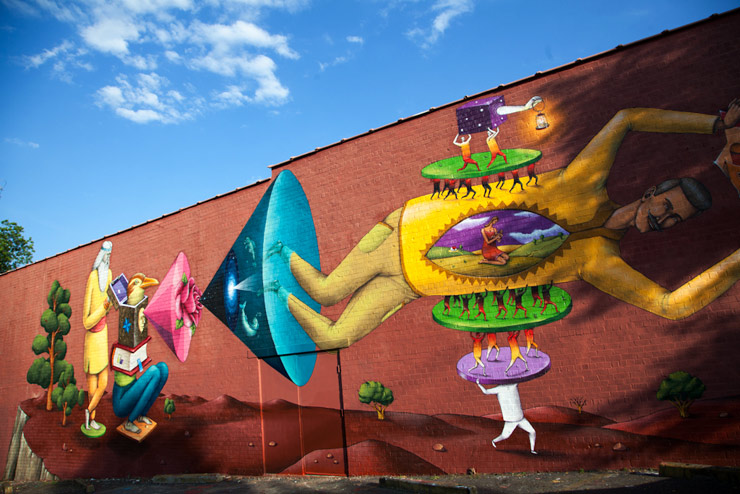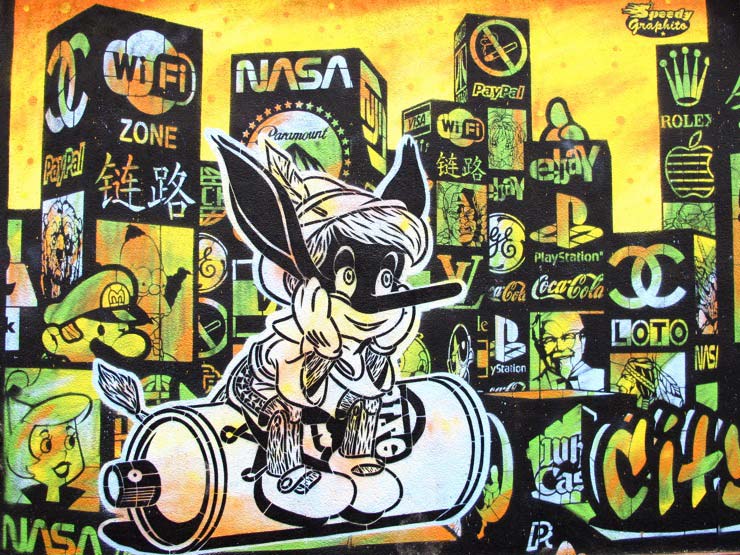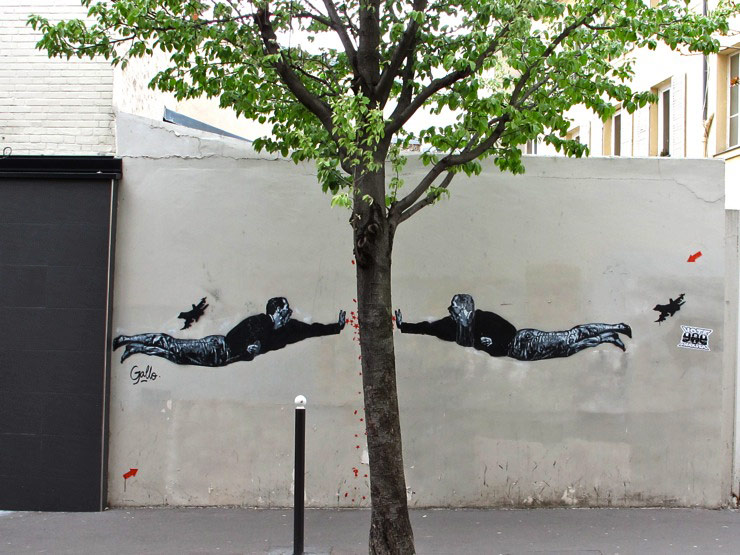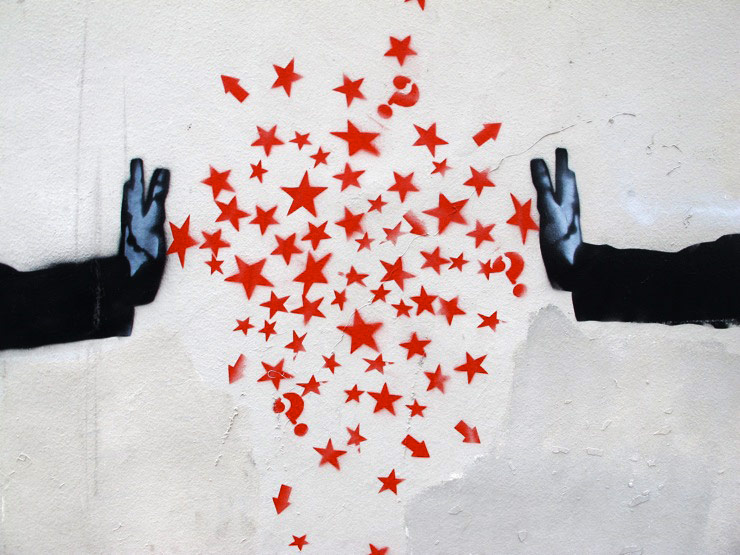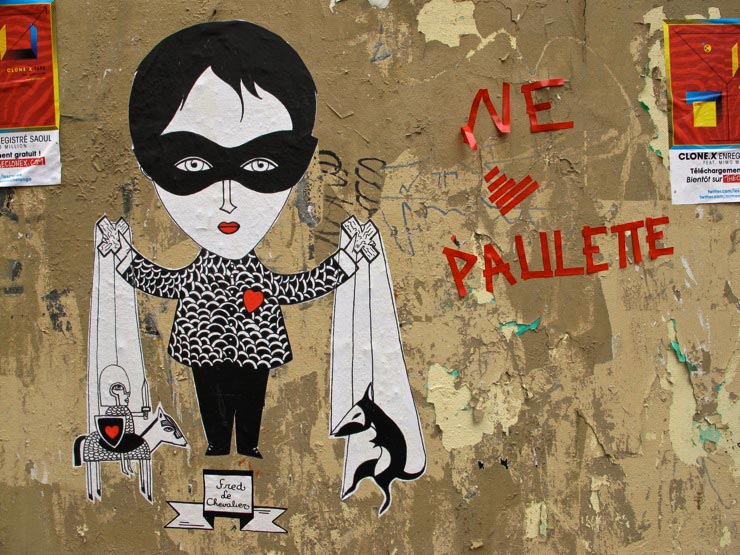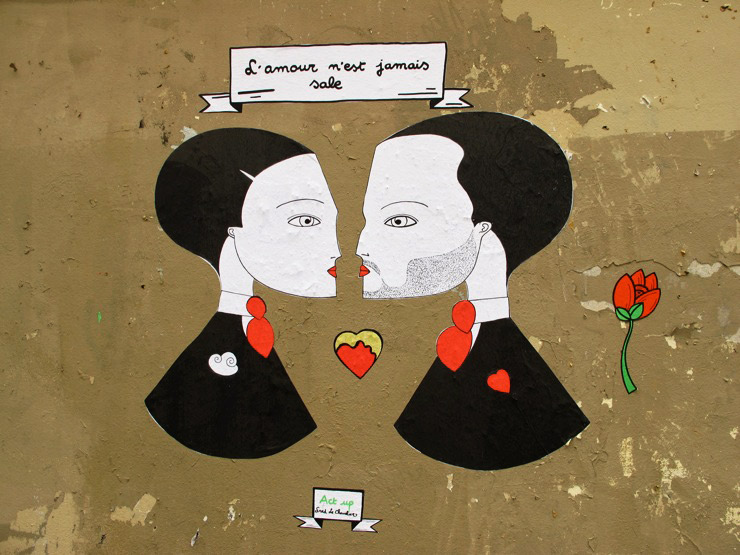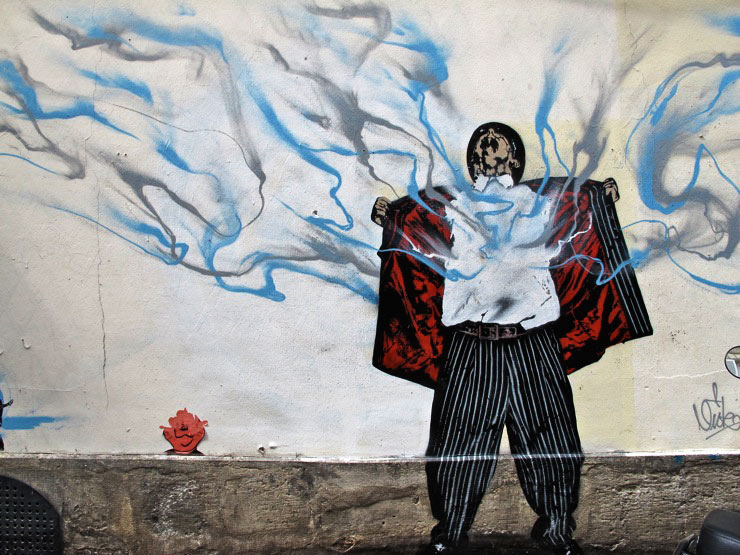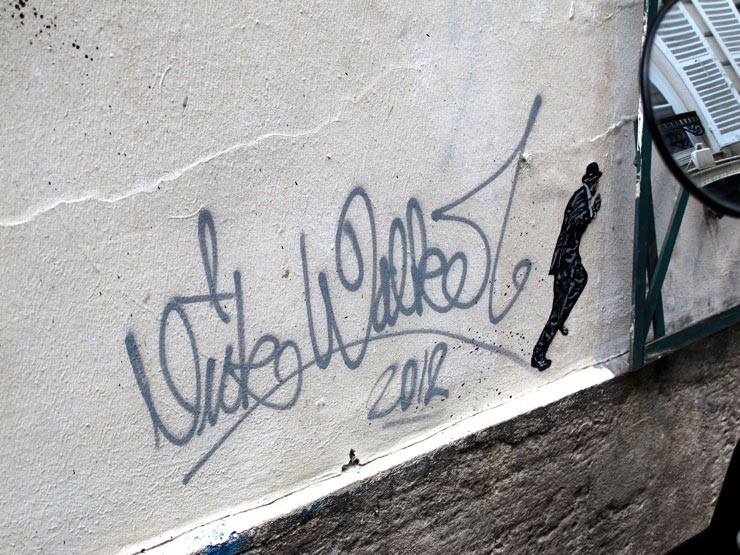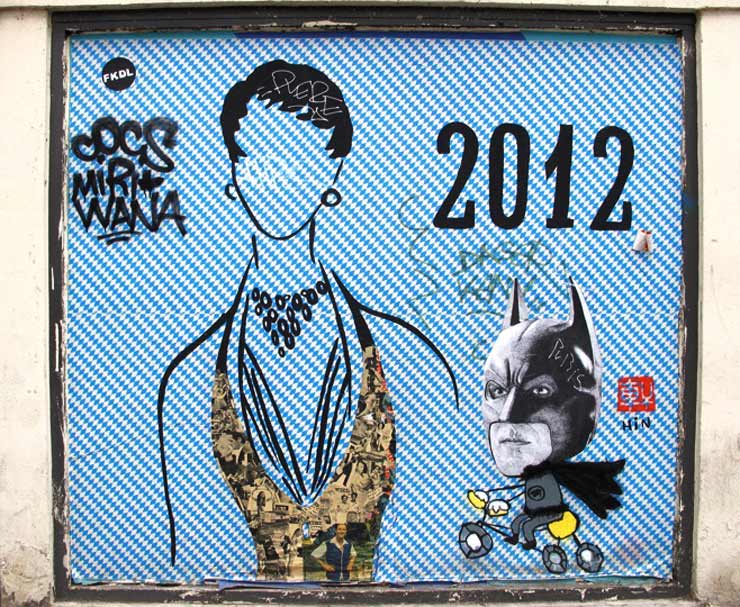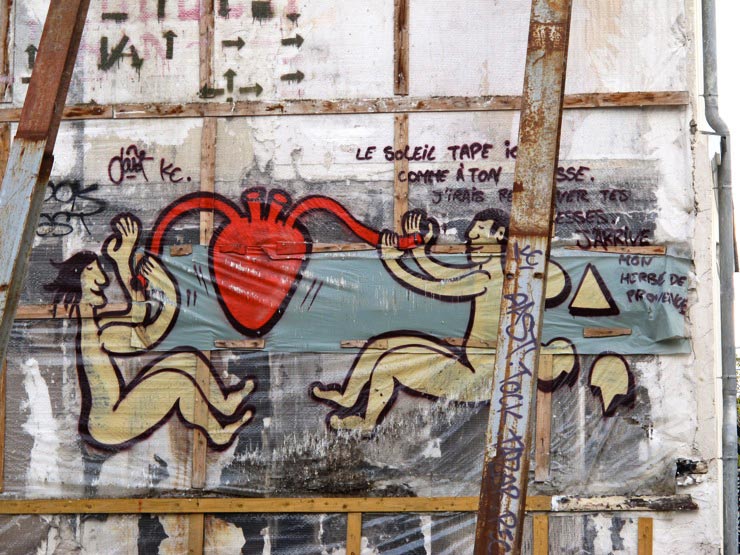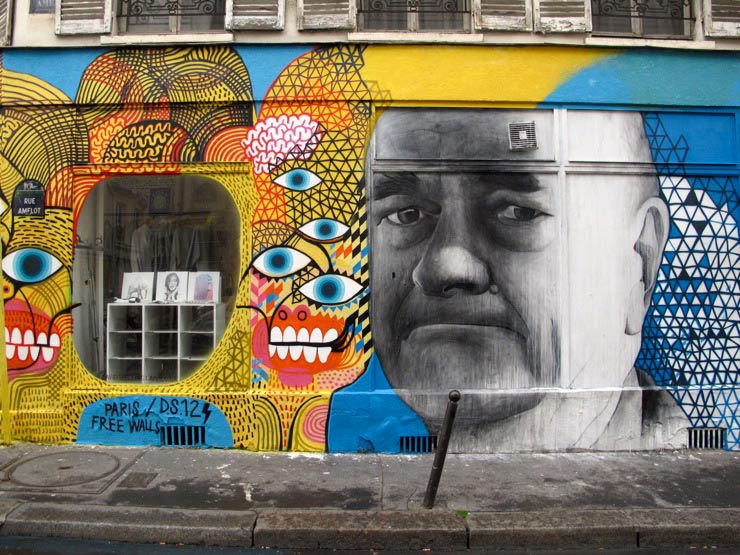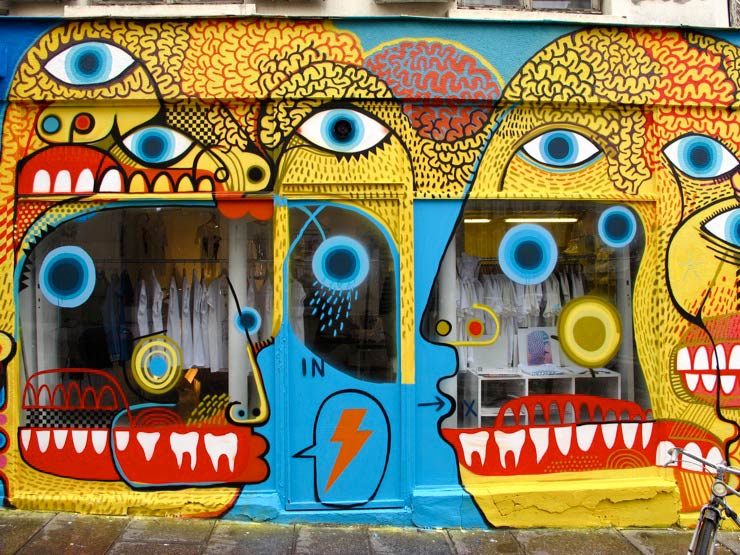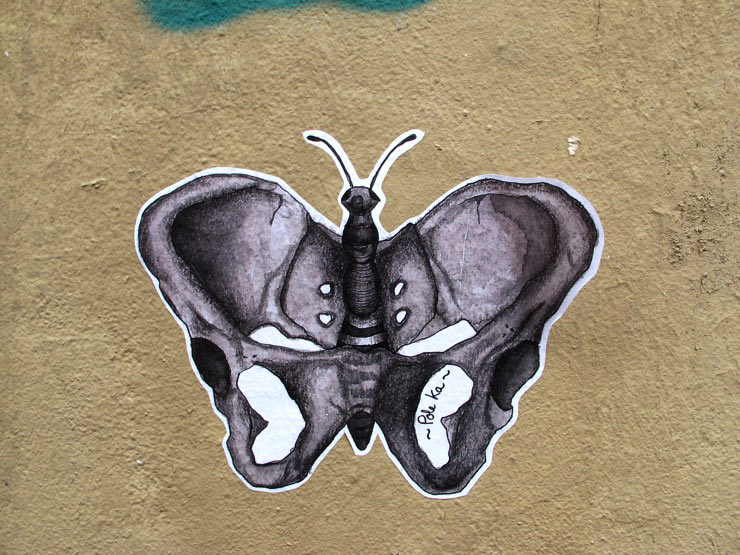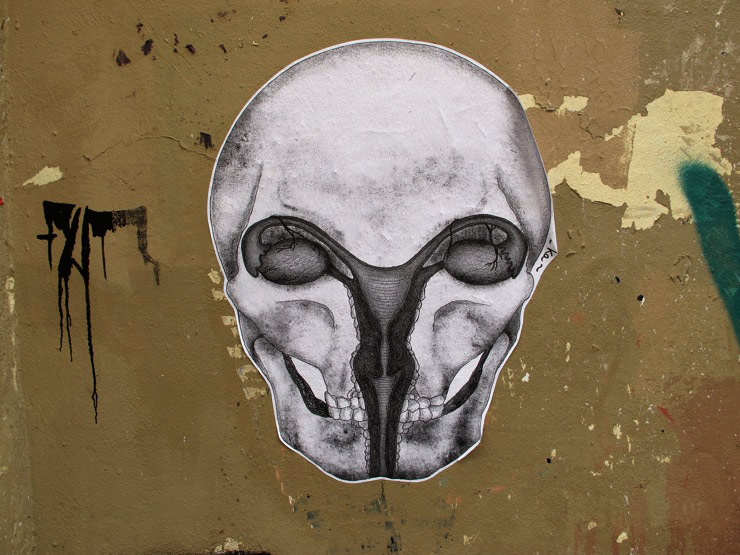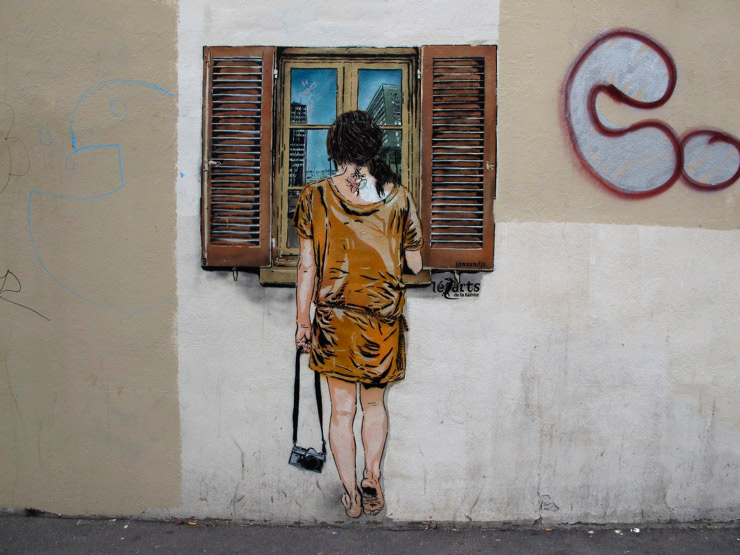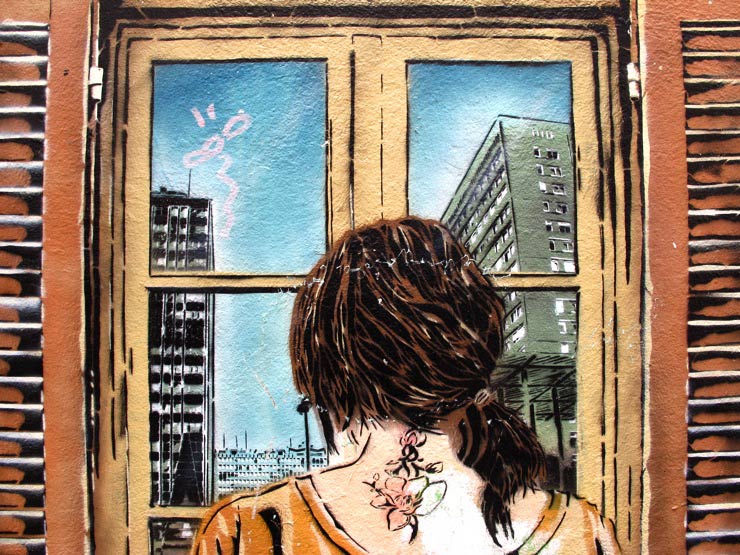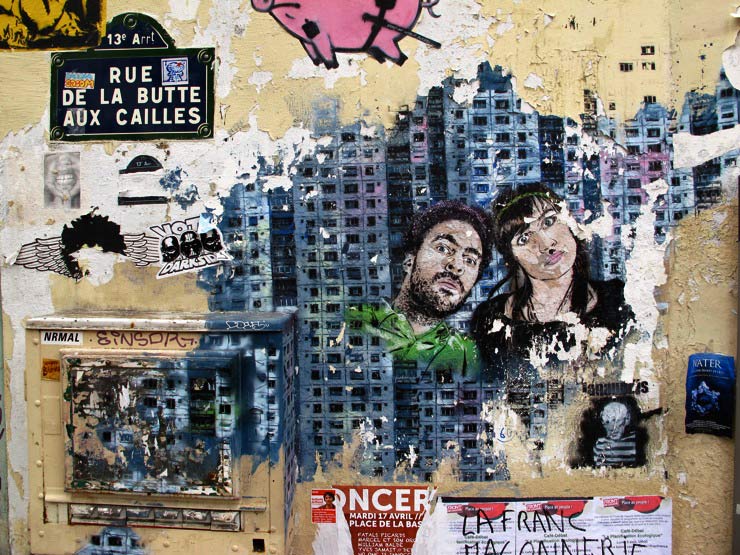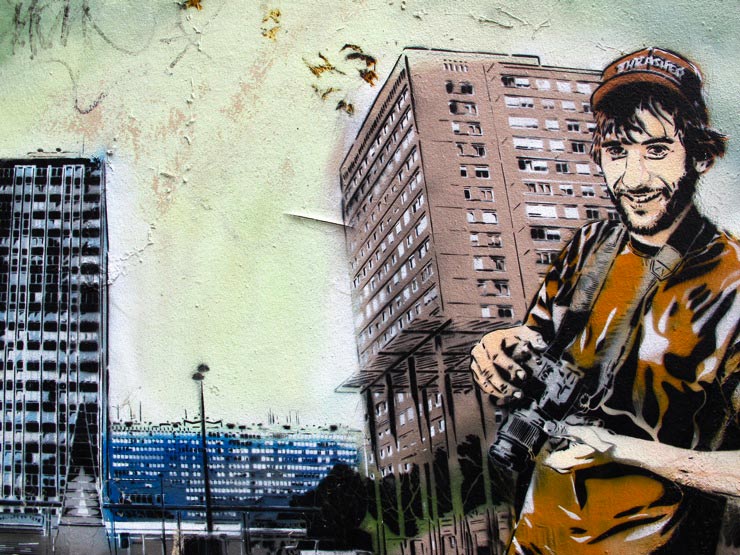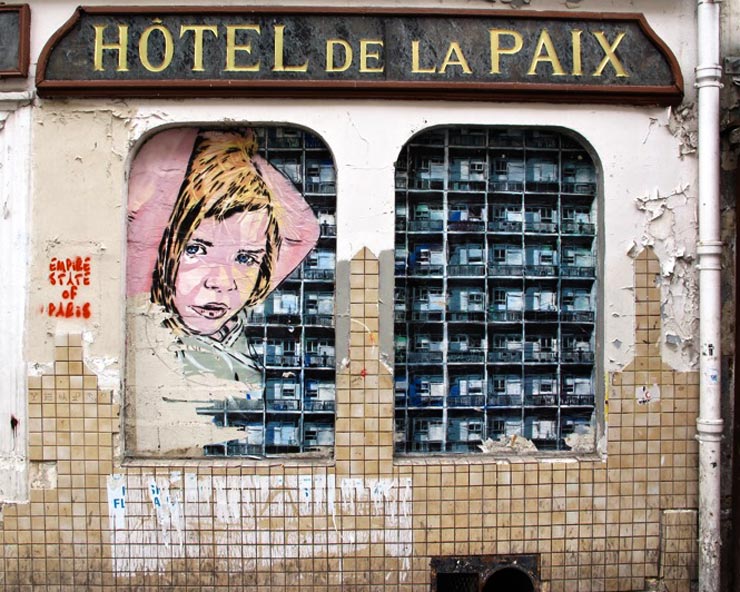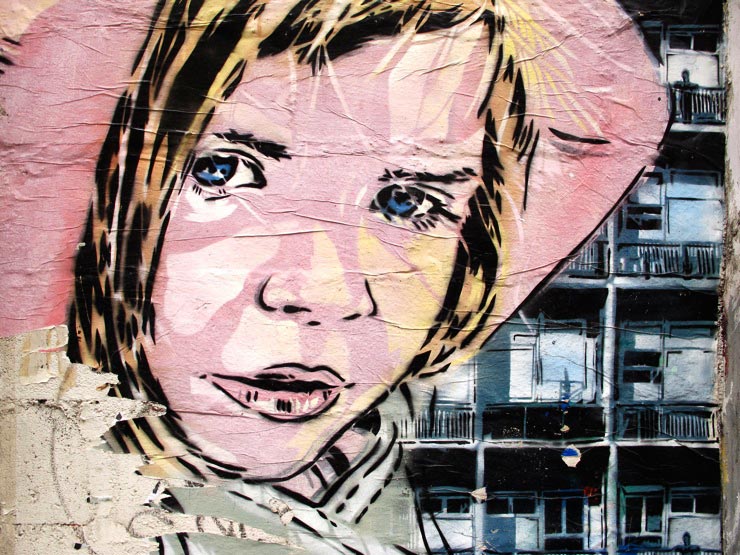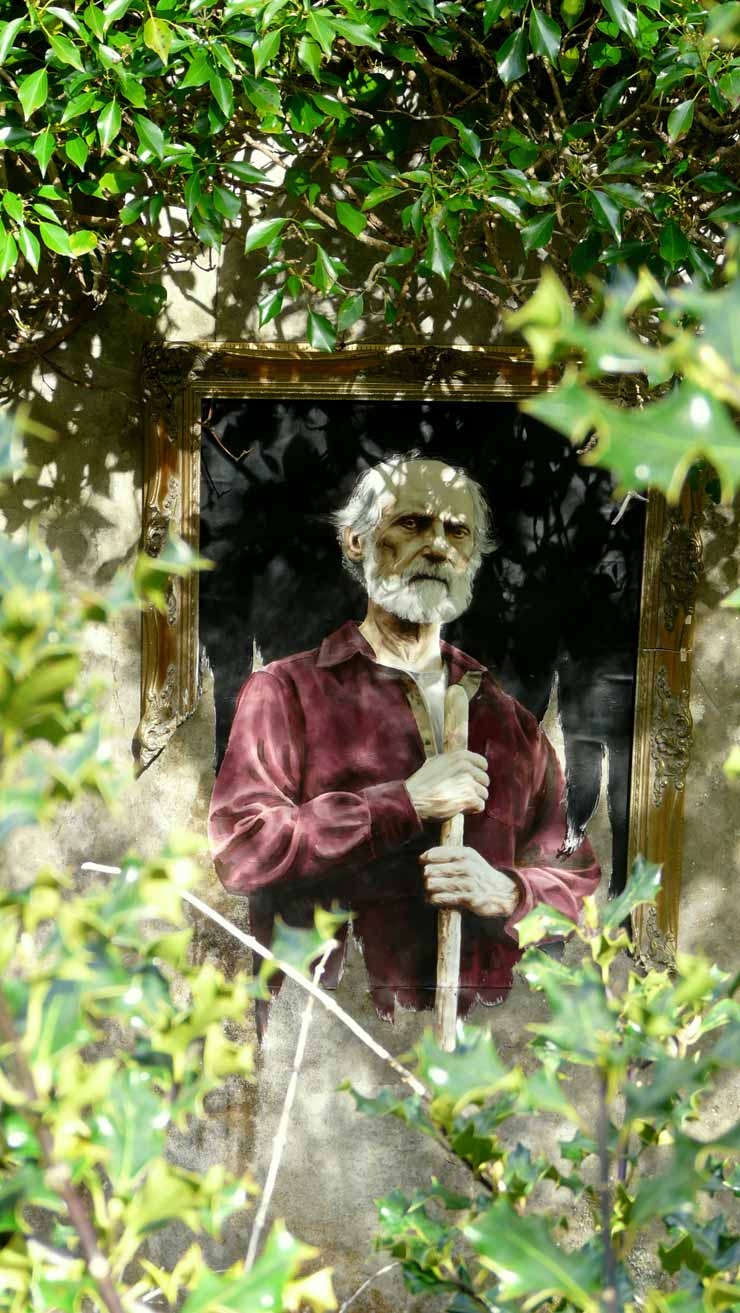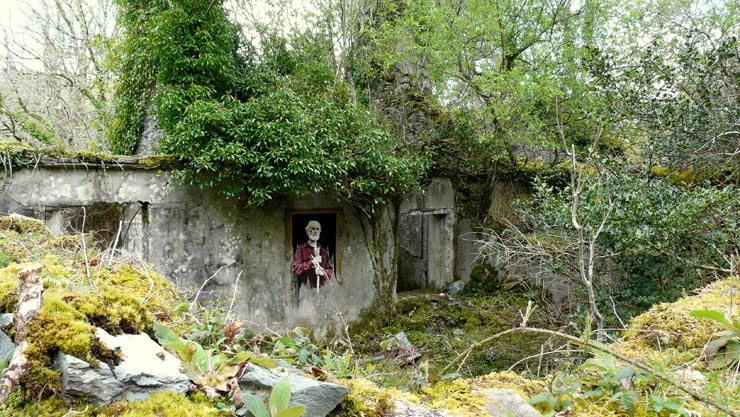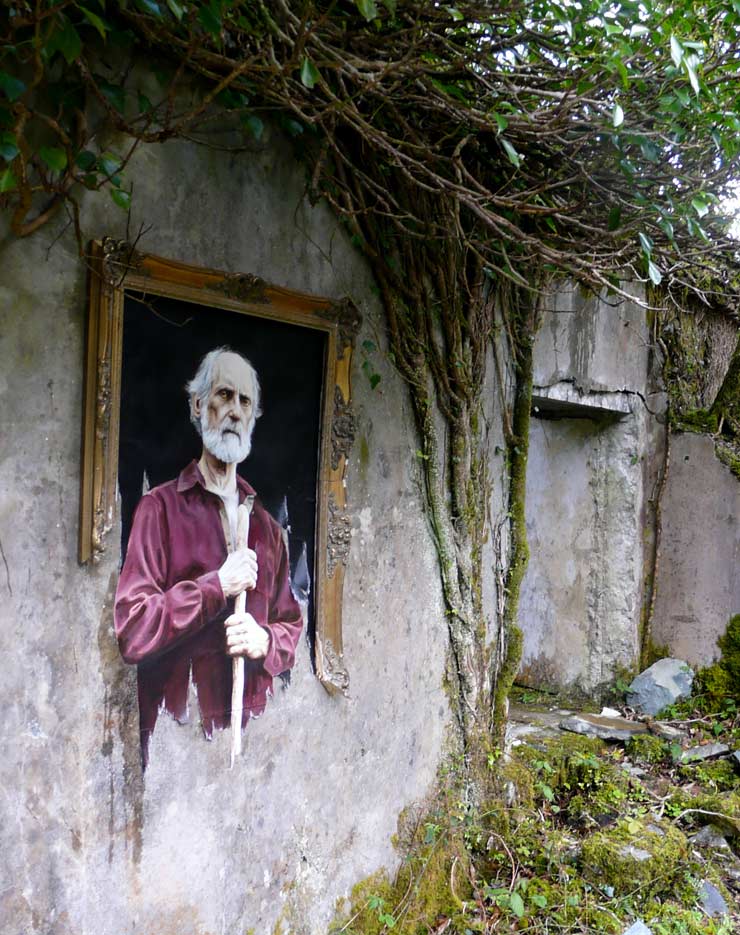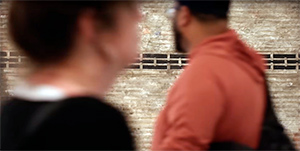“Worked in some countries – in others, not so much.”
Newsflash: Global Street Art is not homogeneous. If you were beginning to think that international Street Art superstars like Banksy and Shepard Fairey had the whole scene on lockdown, Jim Avignon can assure you that will never happen. Each local scene is as individual as the culture it grows from, subject to the opinions and perceptions of the people, politicians, and police in each city. When the Berlin/Brooklyn – based artist traveled to seven countries this spring to organize walls with local artists, Avignon found that scarcity of art supplies or water can just as easily derail a mural as feelings of competition and the fear of the Devil Himself. Working with about 50 artists over six weeks in a cross-cultural Street Art program sponsored by the Goethe Institute, he learned that local is not necessarily global, and all manner of comedy will crop up on the road to a dope wall.
“The main intention was not to have just a wall with ten paintings next to each but to find ways for people to work together,” explains Avignon about the program he brought with Brazilian DJ Holger Beier and curator Alicia Zamora from Nicaragua. “We did an open call via the Internet and Facebook and we asked people to send in designs,” he explains while talking about the mix of Street Artists, graffiti artists, graphic designers, and illustrators who were ultimately selected. The plan included a week of painting and wheat-pasting, followed by a community party to celebrate the new work. Admittedly, they could have been a bit better prepared, but Avignon and team found a variety of working styles, weather conditions, and perceptions about the nature of the art and it’s proper place that they didn’t realize would face them. While the tour was a success in terms of building cultural relationships via Street Art, Avignon says getting people to work together, “Worked in some countries – in others, not so much.”
In English speaking countries the project was called “Urban Heartbeat” and in Spanish speaking countries “De Mi Barrio A Tu Barrio”. Here are images of the various walls and Jim Avignon’s personal observations and experiences, which are illuminating and sometimes very entertaining.
San Jose, Costa Rica (Duration: 7 days)
Our beautiful wall was not only in the center of the city but was also part of the Parliament, which ultimately caused us a couple of problems that we could not have foreseen. Street Art and graffiti art seem to have a long tradition in Costa Rica and our group was well organized and held together by a local artist named Mush. The guys worked so fast that the wall almost looked finished after a day.
Since the wall was a part of the Parliament the press was very keen to find any political statements in our work. They found plenty. Freddy Masis’ monkey character, which had a couple of similarities in appearance with a local politician was next to a gate that let the cars in. So every once in a while when the gate swung open the monkey was behind the gate, giving the appearance of being in jail. TV teams came and made a big fuss, placing upset politicians on camera in front of our wall and all the attention achieved a complete halt of the whole project after three days. The German ambassador had a long discussion with the minister of cultural affairs, and they eventually allowed us to continue and finish.
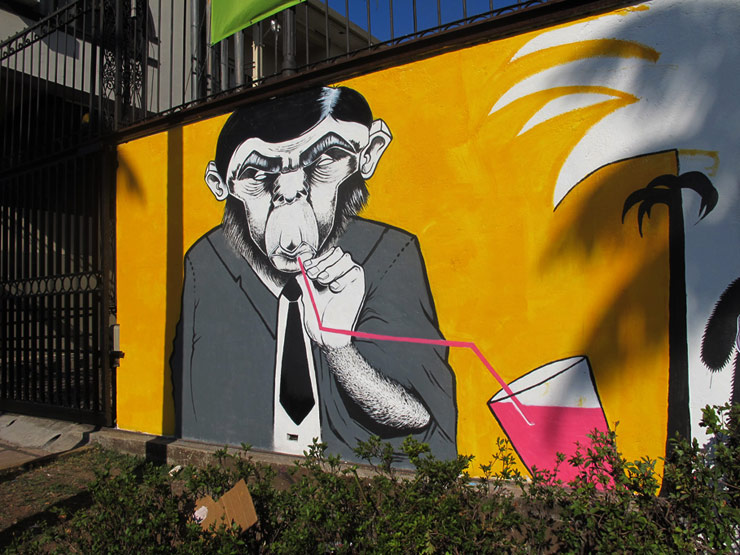
Freddy Masis. San Jose, Costa Rica (photo © Jim Avignon)
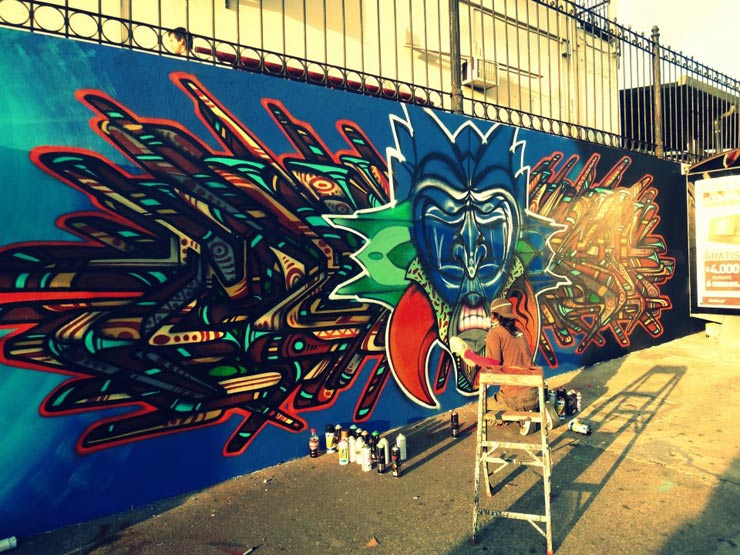
MUSH. San Jose, Costa Rica (photo © Jim Avignon)
Kingston, Jamaica (Duration: 3 days)
Our official wall next to the national stadium was postponed because we couldn’t show a sketch of it in advance. We were moved to a wall that was next to an empty lawn in the middle of nowhere. There were a lot of local kids who came to help but most of the locals were rather skeptical.
Most of these artists had never done a wall before, and they needed some help on how to work large. There was a tendency to start late, with some people only showing up in the morning of the last day. This was our first country and we had no idea how to organize everything – like where to buy paint and get water and provisions, etcetera. In the end there was a nice mood with everybody working at their own place. Some local people thought we were doing the Devils work, unfortunately. The paste-ups that we put up next to the wall all got destroyed in the night. At another time while artists were painting a policeman arrived and told us it would be better if we remove certain images which were considered devilish – like one portrait that showed a third eye. It was clear that if we didn’t repaint, the walls would be repainted for us, and that actually happened in the night after the opening party. It seemed like it would be a difficult country for young artists.
For our celebration party the sound system was giant and very impressive – too bad nobody knew about our party and only a few people came, the foreign minister among them – which didn’t impress the local artists.

Group Wall. Kingston, Jamaica (photo © Jim Avignon)

Group Wall. Kingston, Jamaica (photo © Jim Avignon)
Managua, Nicaragua (Duration: 5 days)
We had a very dusty and moldy wall next to the university. There were a lot of trees around so we had some shadow but also it was a bit difficult to take photos. We had to prime the wall by ourselves – a task that consumed almost half of the time we had allotted for the project. Finding and purchasing the paint at the Mercado Oriental (a very big local market) turned out to be difficult and we got lost and almost didn’t find our way out there.
The Nicaragua experience was rather tough as most of the artists didn’t speak any English and we had to deal with 3 generations of sprayers, who were all a bit suspicious about us and the project. They believe that Graffiti in Central America started in Nicaragua, and therefore didn’t want anyone to come and tell them how to do it (which we never had in mind). Additionally, the painters didn’t want to deal with the paste-ups or collaborate with the participants from other countries. The final challenge was that they understood the whole project as a competition that they wanted to win, and they kept claiming that they were the best. Indeed one could say that they had a very unique style; they were all focusing on natural and pre-Columbian imagery, a bright range of colors, and avoiding “negative” images like skulls or guns. They also avoided any influences of contemporary pop culture and did not want to put their images on any blogs or Facebook. I was fascinated and irritated about it and for 3 days the mood while working was relatively down, while only on the last day it cheered up a bit.
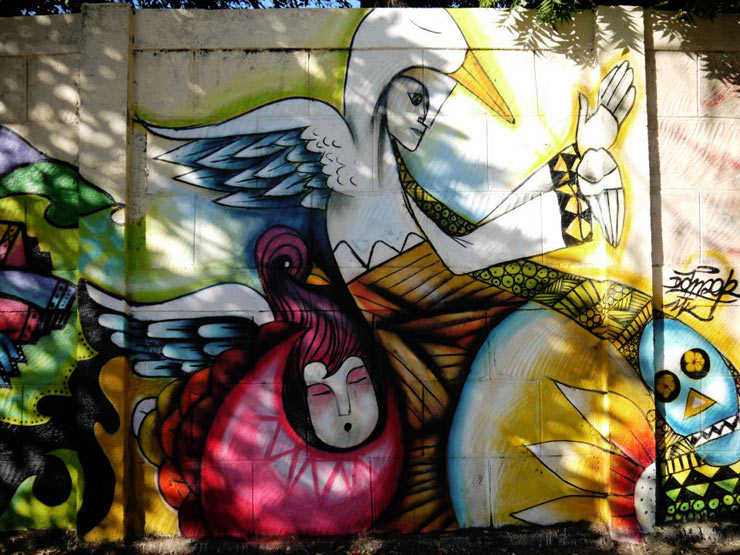
STK, Danser. Managua, Nicaragua. (photo © Jim Avignon)
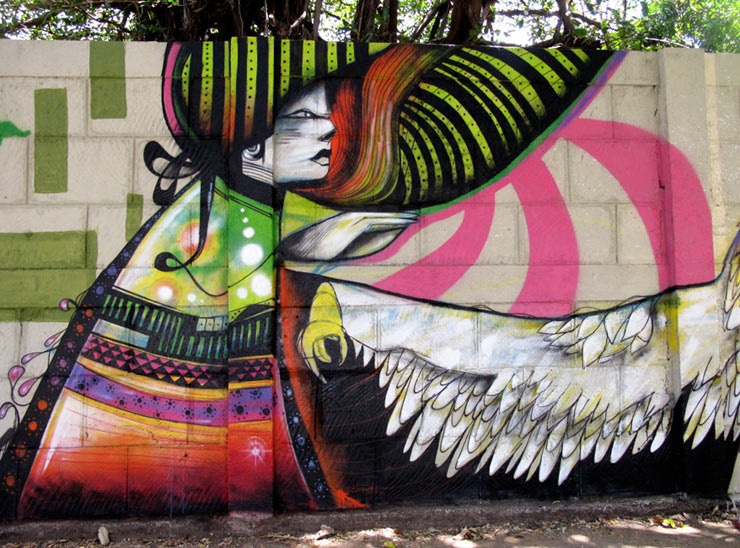
Stchex, STK. Managua, Nicaragua. (photo © Jim Avignon)
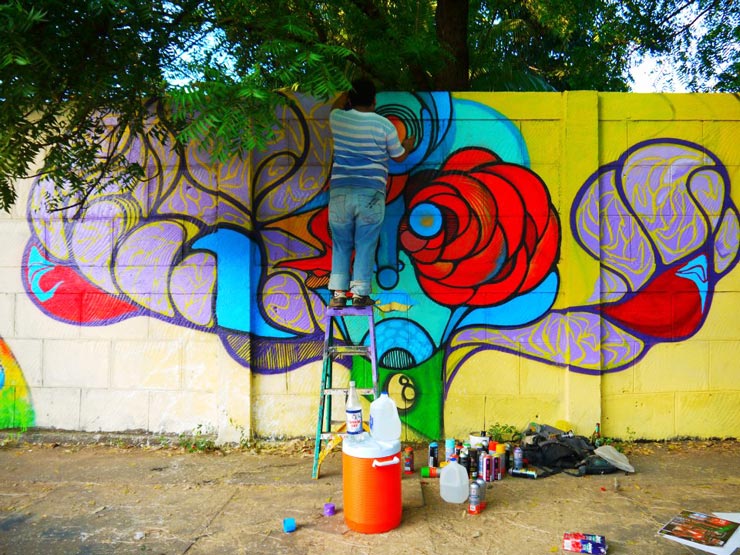
Simer. Managua, Nicaragua. (photo © Jim Avignon)
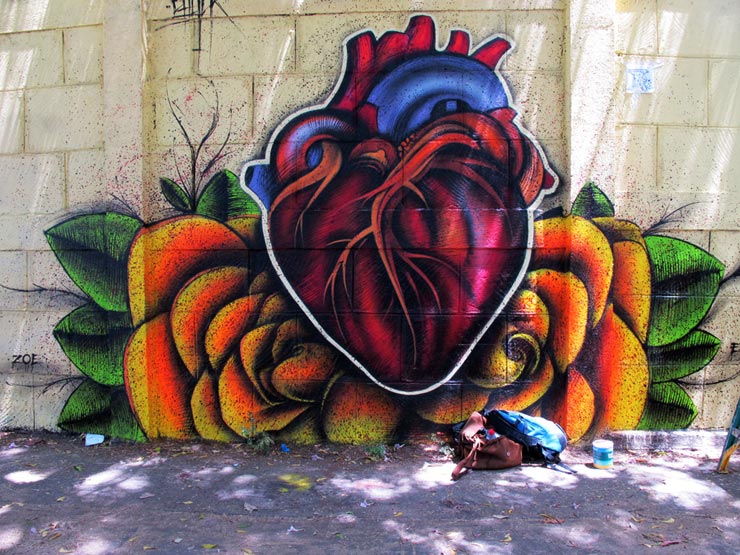
Dorian Serpa. Managua, Nicaragua. (photo © Jim Avignon)
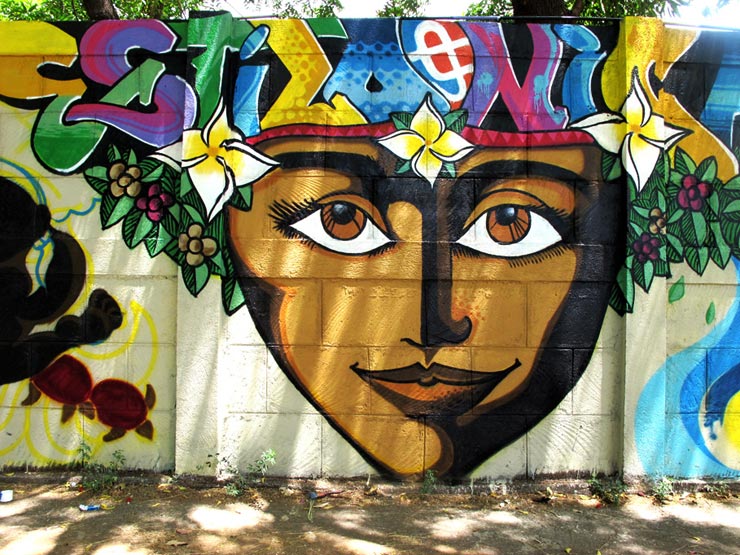
Brake Rivas. Managua, Nicaragua. (photo © Jim Avignon)
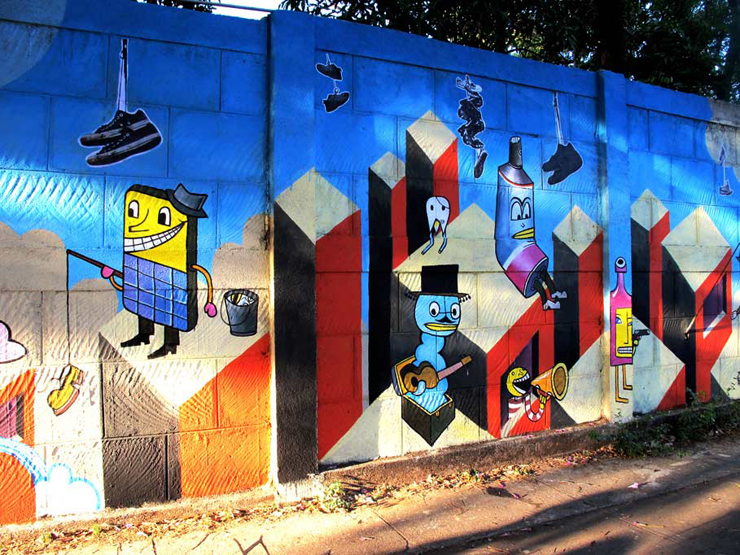
Jim Avignon. Managua, Nicaragua. (photo © Jim Avignon)
Panama, Panama (Duration: 7 days)
Our walls were in a very nice place in the old part of the city with two walls facing the ocean, the others on the side of a building. Kids came and skated around and played football while we painted but there were no shadows and there was a lot of direct sun beating down on us.
Panama City seems to be on the way to becoming the next Singapore or Dubai; There is a brand new skyline in the south of the city, money is a big issue, and the population is very mixed, almost like New York. We had a nice mix of artists, and they were pretty open to letting their work merge with one another’s art. Also all of them seem to be quite professional – trying to make a living from their art and many saw our project as a promotional platform. Sadly, the local organizers tried to cut down expenses and it resulted in no water for the artists and no money for paste-ups. To overcome these obstacles, we made our planned paste-ups out of a hundred A4-sized sheets of paper and some bad moods. There were also plans to make some money with our opening party, which would have stopped the nice people from coming. We fought against it and in the end the party was free and there were more than 400 guests.
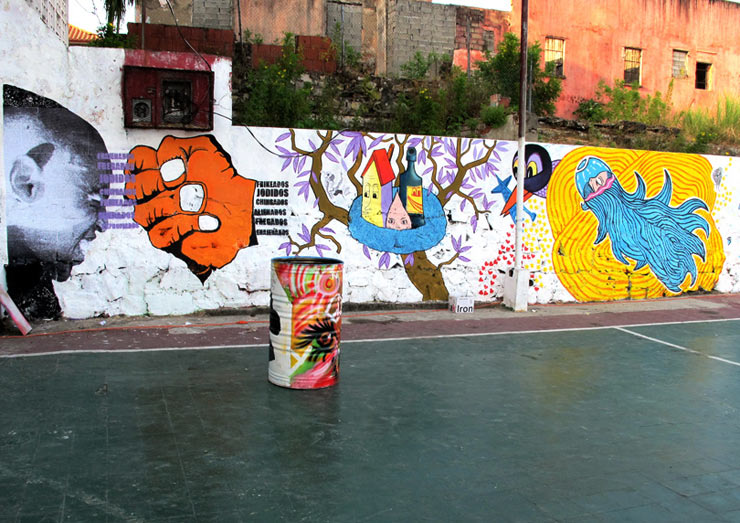
Gladys Turner, Alexandr, Jaramillo Levleva. Panama, Panama. (photo © Jim Avignon)
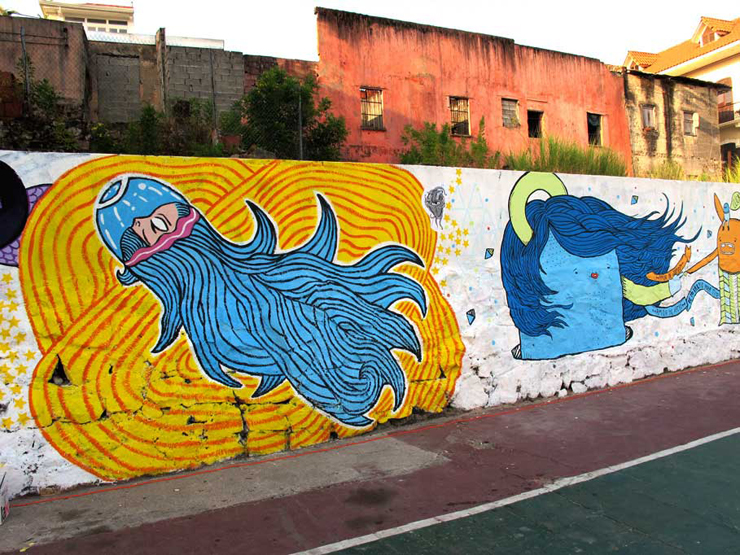
Alexandr. Panama, Panama. (photo © Jim Avignon)
Port of Spain, Trinidad (Duration: 4 days)
We had a nicely prepared wall next to the Savanna – a big arena where the Carnival happens every year.
The situation was a bit like the one we had in Jamaica. Music is the much bigger business here and there is not a big tradition for painting in the streets. There is only one famous Street Artist, who had painted birds in black and white all over the city, but he now has moved to Mexico.
None of our artists had worked on walls before and they came from a graphic design background. It was a well mixed group but also I had a feeling that many of the artists were sort of introverted and they just focused on their individual work without interacting with the other artists. I didn’t do a piece of my own but helped everybody with the backgrounds and the graduations. This was the first time we were done with the wall a day earlier than planned. Our celebration party in Trinidad was the biggest one of the tour with over 500 people, free food and drinks, a bunch of DJs, and a big capoeira dance group performing.
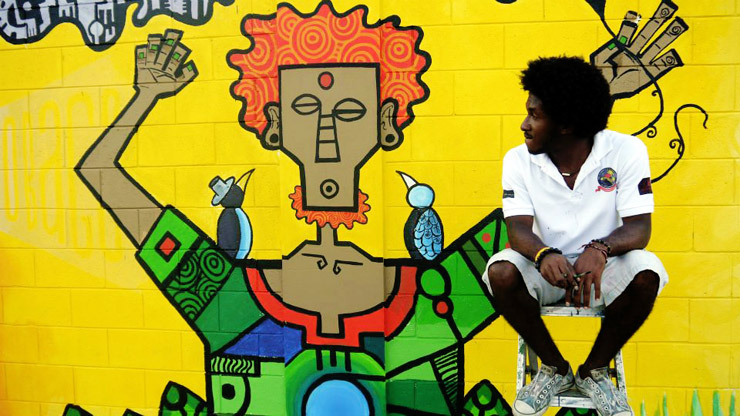
Kriston Banfield. Port of Spain, Trinidad. (photo © Jim Avignon)
Santo Domingo, Dominican Republic (Duration: 7 days)
Because all of the central part of Santo Domingo is a historical landmark it was impossible for us to get a wall there. The organizers considered the suburbs to be too dangerous so instead they found us an abandoned tower next to the harbor with a large semi-indoors space. Here they covered the walls with four giant canvasses. In front of the canvasses was a big scaffolding, making it pretty much impossible to get a view of the wall while we working on it.
There is not much of a big Street Art culture in Santo Domingo and during a tour through the suburbs we saw some nicely painted shags and delis – but that was it. Naturally it was no surprise almost all our painters came from at least a semi-academic background and when you combine that background with the fact that everybody had to paint on canvas, it pushed the entire project in a different direction. Paint was difficult to get and only came in pre-mixed colors that were not very bright. We were disappointed by some of these things but on the other hand the organizers brought food every two hours. It was no surprise that everybody worked rather slowly and thoughtfully. We decided pair up two artists for each canvas, and the nice results told us that it was a good decision.
Sadly, after one week of sunshine there was a heavy thunderstorm on the night of the opening party and it destroyed any party feelings that we had.
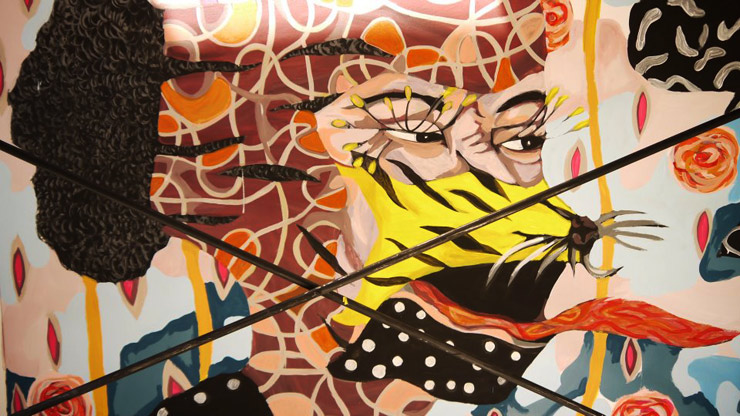
Citlally Miranda. Santo Domingo, Dominican Republic. (photo © Jim Avignon)
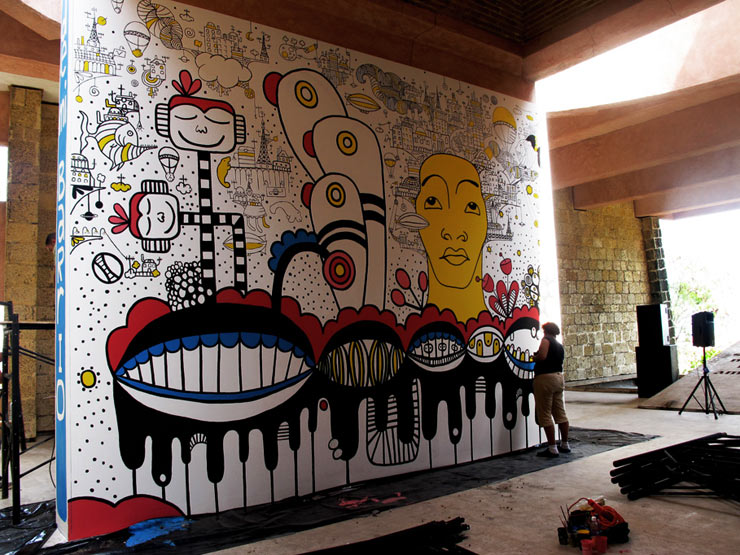
Ana Leon and Luis Geraldino. Santo Domingo, Dominican Republic. (photo © Jim Avignon)
Guatemala, Guatemala (Duration: 4 days)
For our final city we had a 120 meter wall that was pre-painted cyan blue in the heart of the city next to the main square. Also there was electrified barbed wire on top of the wall, which we were told we should not touch under any circumstance.
Our group of artists was mixed in a good way; graffiti guys, illustrators, street artists, half guys, half girls, and all of them spoke English. Artist Fla K.O., a local hero, helped to get everything organized and the mood was really nice, with us meeting the artists every evening for drinks.
Painting the wall was more of a difficult situation. Many people were carrying guns around there and brutality on the streets is a big issue. One artist Lily Acevedo made the stencil of the portrait of an 8 year old kid that had been killed in the streets a few weeks earlier. Just as we began painting the wall the city began a construction project that included tearing up the street and replacing the old cobblestones with new ones. Artists mixed with street workers, and there was a TV team around us making a documentation of the project. It was difficult to get good photos of the wall without artists standing in front of it. It was a bit of a mess but also it was funny situation many times.
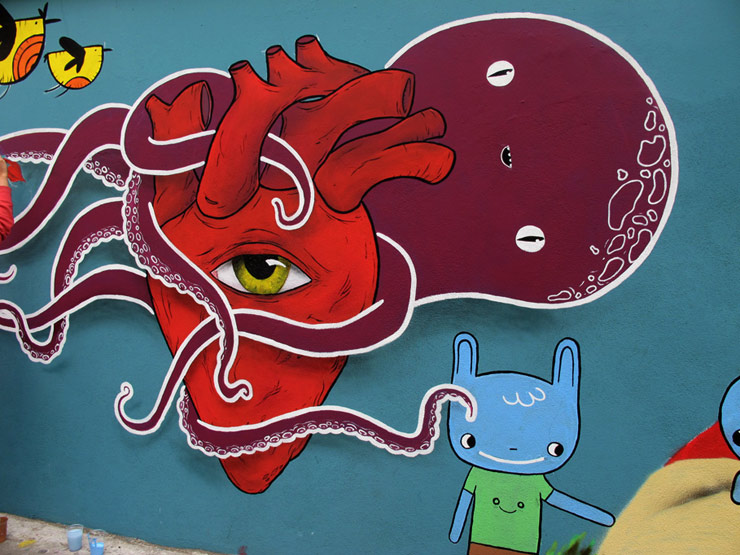
Zapato Verde. Guatemala, Guatemala. (photo © Jim Avignon)
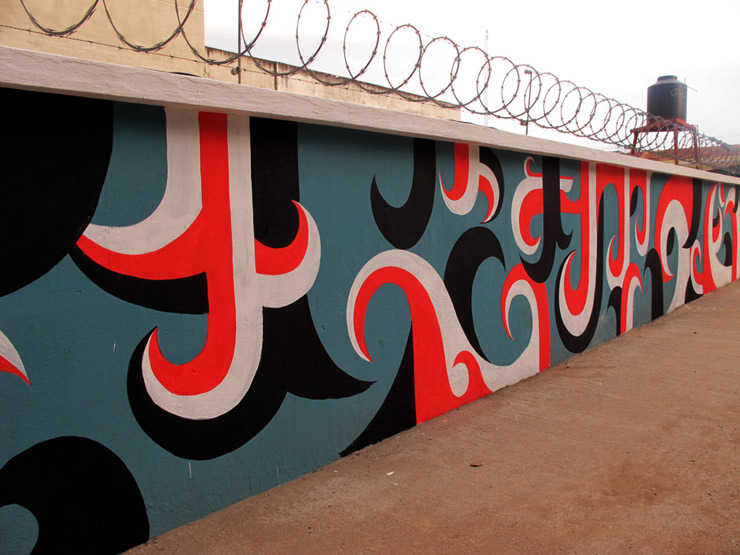
Jim Avignon. Guatemala, Guatemala. (photo © Jim Avignon)
The list of participating artists in the program are as follows:
Trinidad:
Brianna McCarthy, Richard Taylor (para Richard Williams), Danielle Boodoo-Fortune, Luis Vasquez La Roche, Dean Arlen, Jennifer Perez, Kriston Banfield, Alicia Milne, Raquel Vasquez y Maria Elena Joseph
Nicaragua:
Dorian Serpa, Caroline Broisin, Moises Garcia, Jose Luis Zapata, Rafael Antonio Rivas, Danilo Espinoza, Roger Roke Romero, Guimel, Angel Soto, Jean Philip Meio, Christian
Guatemala:
Fla.Ko, ES Bird, Alebara, Cheks, Petunia, Lily Acevedo, Zapato Verde, Luis Fer Izquierdo, FUENTES, WAKA, ZOAD1, Sexi Zombie, Rodrigo Aguilar, Hans Uno, ARIZ y Mr.KrazyMan
Dominican Republic:
Angel Urelly, Luis Geraldino, Luis Hidalgo, Ana de León, Coller Art, Citlally Miranda, Jose Ramia, Carlos Estrada, Patricia Grassals
Panama:
Fabrica de Malvaviscos, Purple King Crew, Nel One, Alexandr Jaramillo Ievleva, Rolodesedas, Manuel Choy, Thomson Moore, Jaqueline Brandwaym Fallenbaum, Veco La Tienda de Remedios, Gladys Turner Bosso
Costa Rica:
Mush, Piloy, Piem Quesada Cedeno, Alfredo Flores, Ghoke, Zisco, Gussa, Yiyo, Nava Remix Bang, Jairo Miranda, Chesr, Diego Fournier y Freddy Masis
Jamaica:
Naecia Dixon, David DaCosta, Amanda Choo Quan, TAJ, Dahcia Hong, Ikem Smith, Naita Chamberlain and Jonoi Messam
<<>>><><<>BSA<<>>><<<>><><BSA<<>>><><<>BSA<<>>><<<>><><BSA
Please note: All content including images and text are © BrooklynStreetArt.com, unless otherwise noted. We like sharing BSA content for non-commercial purposes as long as you credit the photographer(s) and BSA, include a link to the original article URL and do not remove the photographer’s name from the .jpg file. Otherwise, please refrain from re-posting. Thanks!
<<>>><><<>BSA<<>>><<<>><><BSA<<>>><><<>BSA<<>>><<<>><><BSA
 BROOKLYN STREET ART LOVES YOU MORE EVERY DAY
BROOKLYN STREET ART LOVES YOU MORE EVERY DAY